Travels with Dick and Karen
Paris
Part 4
South looping to NE
(the Light Green Line path) |
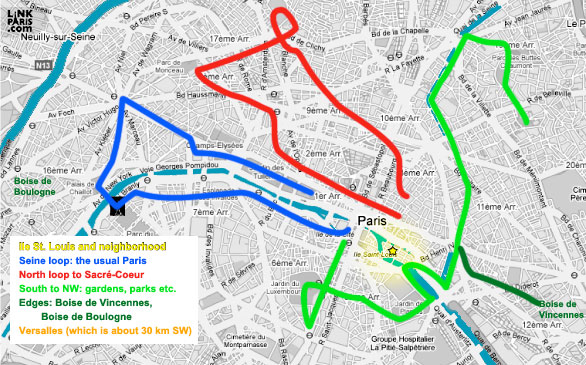 |
| Starting just south of Notre Dame, across the Seine via Pont St Michel, is Place St. Michel. |
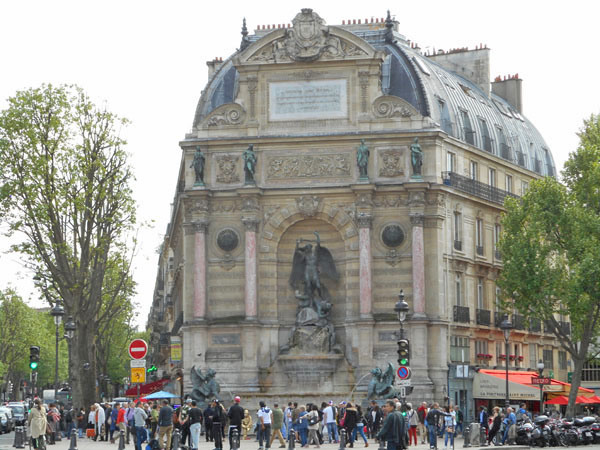 |
with its monumental fountain of Archangel Michael wrestling with the devil. The ancillary lion-headed dragons added that Je ne sais quoi. |
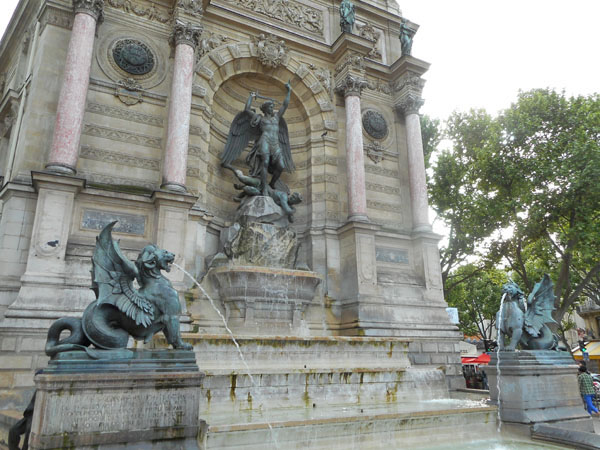 |
It is in an area of galleries |
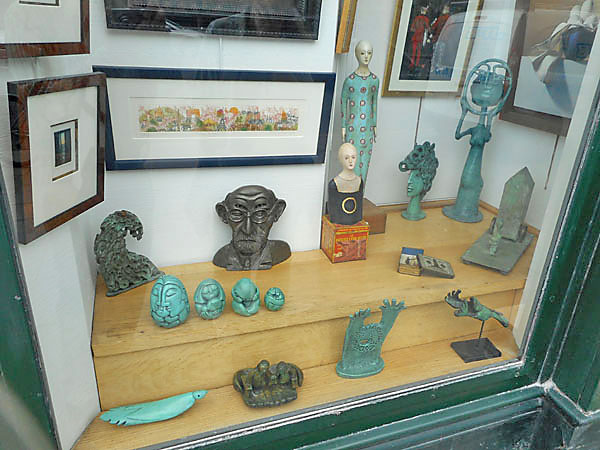 |
| And things to fix up your home. Here a store specializes in hooks. |
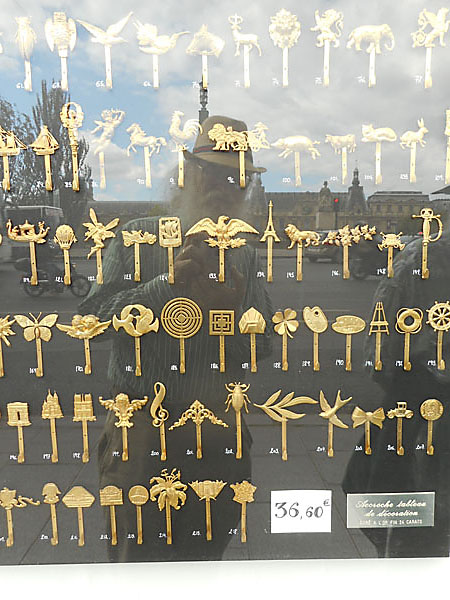 |
| The building that was once the townhouse of the abbots of Cluny now houses the Musee National du Myen Age (Medieval Museum). The day we visited was a "free day" (first Sunday of the month) and quite busy. The museum had student volunteers from one of the universities answering questions and assisting visitors. |
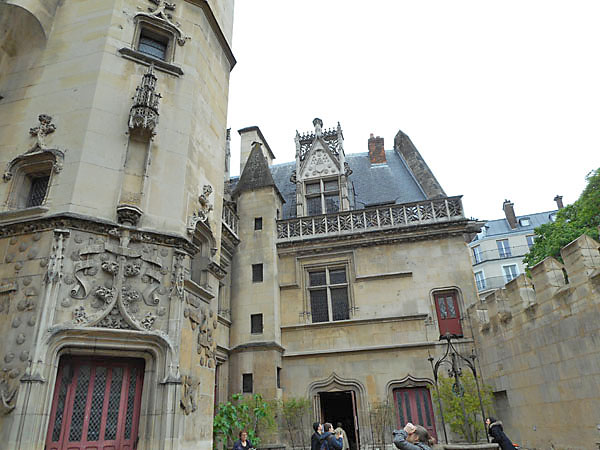 |
| Well-displayed stained glass that had been rescued from Sainte-Chapelle |
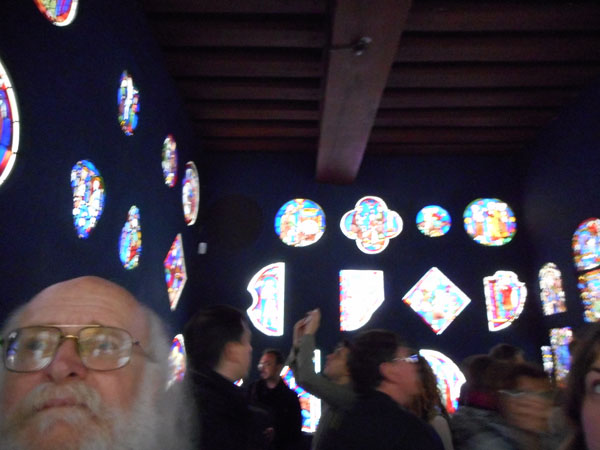 |
| We could get our noses (and cameras) up close to see construction and repair details. |
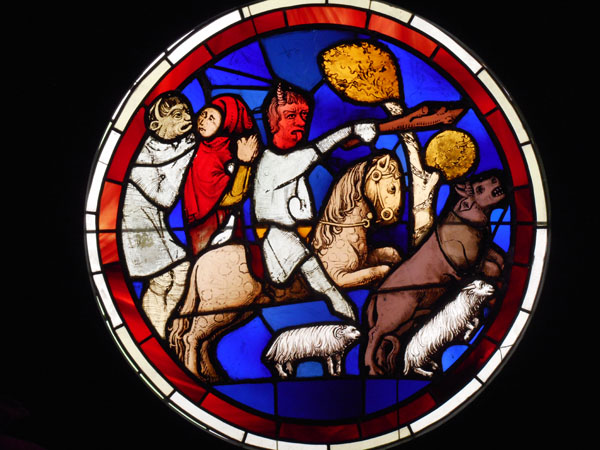 |
Reliquaries |
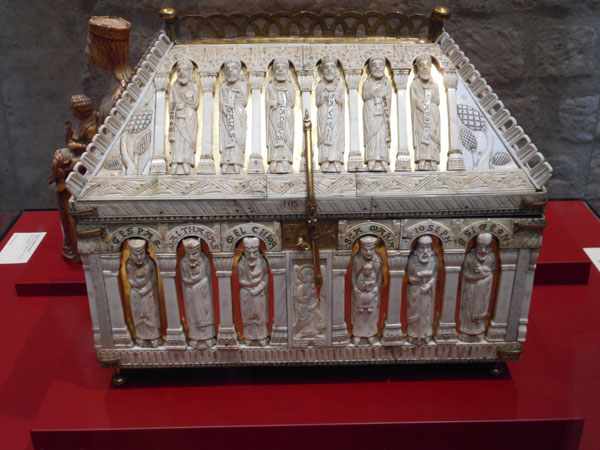 |
| Lots of religious and not-so-religious art |
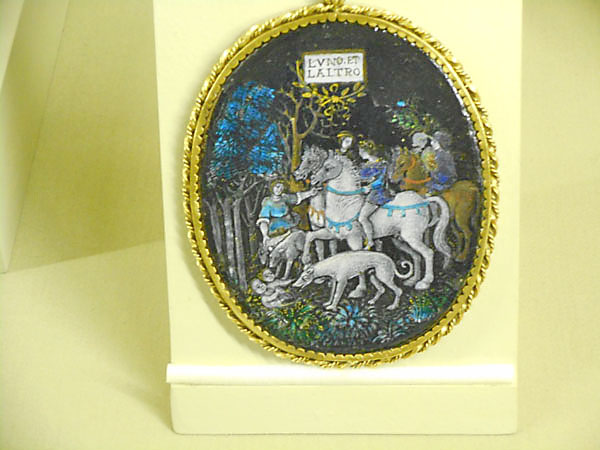 |
The museum is known for the "Lady and the Unicorn" Tapestries. There are all six wall-sized pieces surrounding you in one (crowded) room |
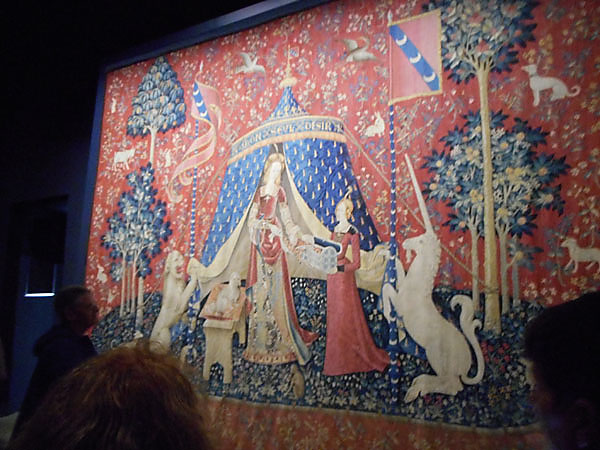 |
| But there are many other tapestries here too. This is a short section of a continuing story that snaked through many rooms. "Word ballons" existed long before modern comic books. |
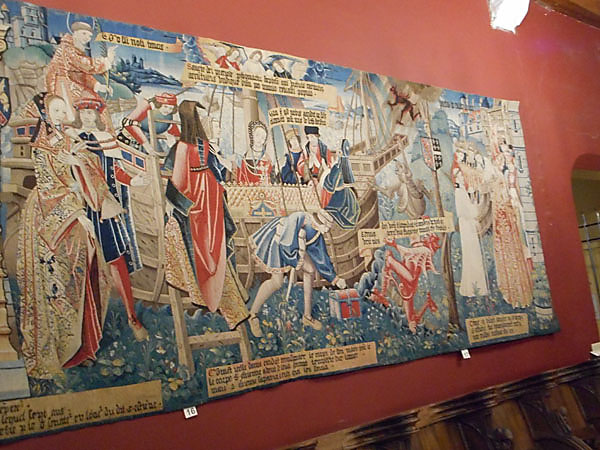 |
| A small but interesting display on warfare and several less bloody games. |
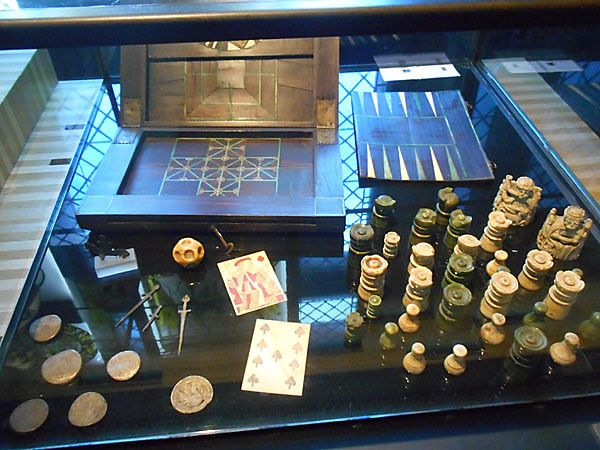 |
| The building itself was an exhibit unto its own right, |
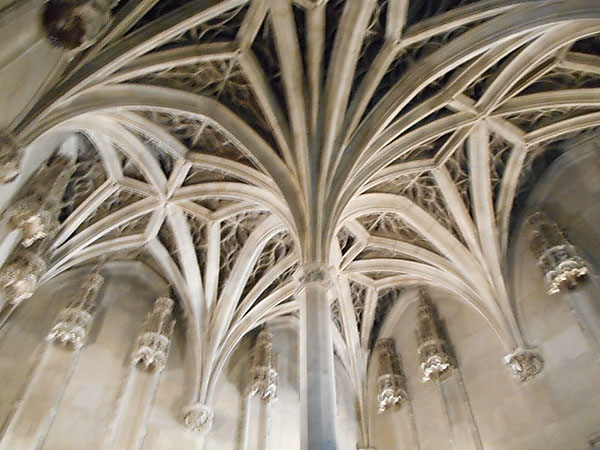 |
| along with other exhibits showing medieval architectural details |
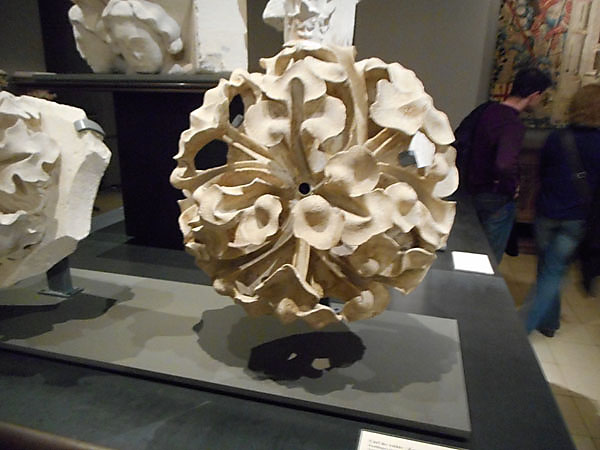 |
| The Hôtel de Cluny itself sits on an even older Roman bath which is still being excavated and explored. |
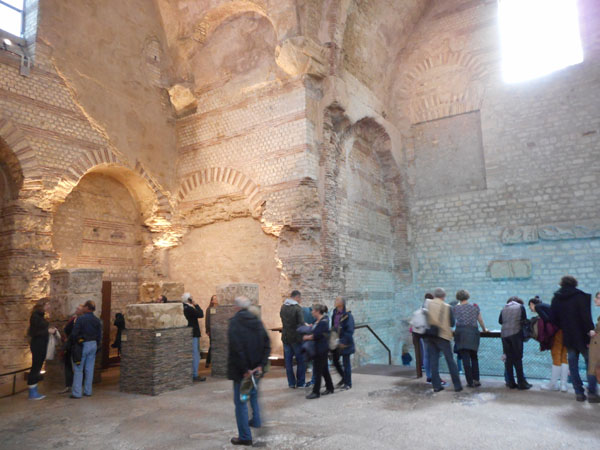 |
| One of the pieces displayed is this typical Roman bath mosaic |
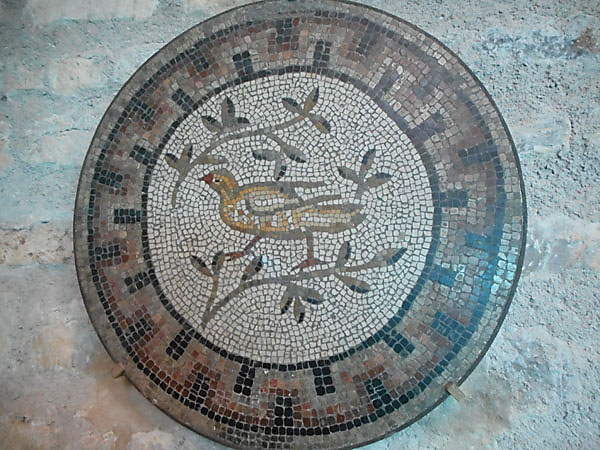 |
| Returning to the surface and surrounding streets, we admired the door of Université Rene Descartes, part of the Sorbonne. There was a pause as we worked out "university of all knowledge that follows" |
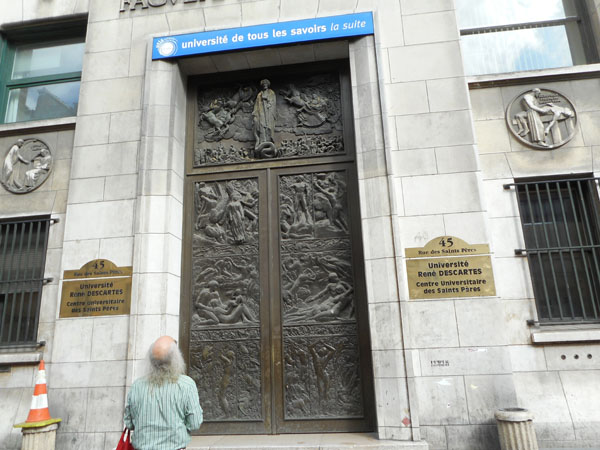 |
| The Sorbonne extends for blocks, and includes a couple of observatory domes. (Notre Dame in the distant background). |
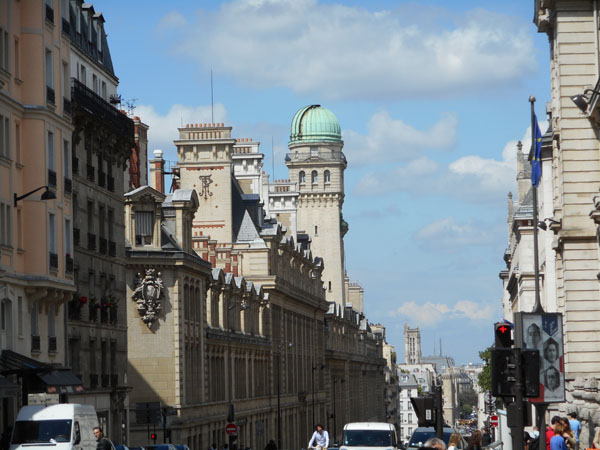 |
| Continuing south past it and all the way up Boulevard St Michel you get to the Fountaine de l'Observatorie |
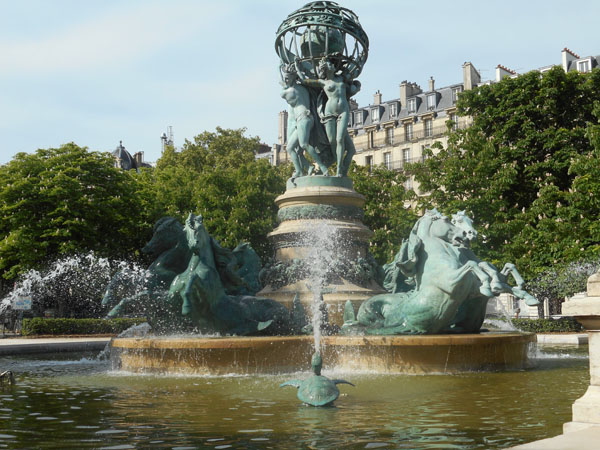 |
| We turn north and walk down through the long but narrow swath to the ... |
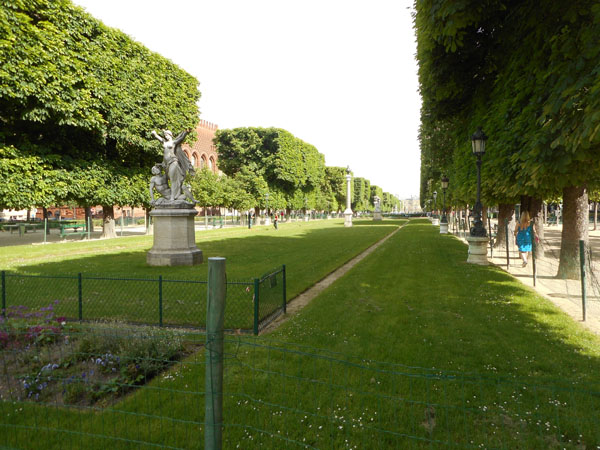 |
Jardin Du Luxembourg.
(the previous photo was taken at the red dot on the upper right) |
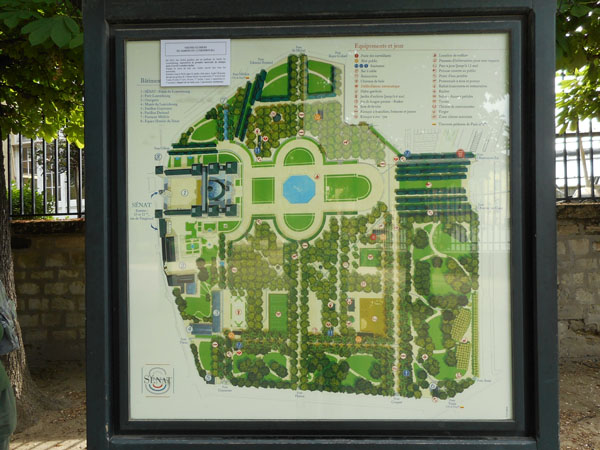 |
| The highpoint for us was the Medici fountain, tucked into its own quiet grotto. |
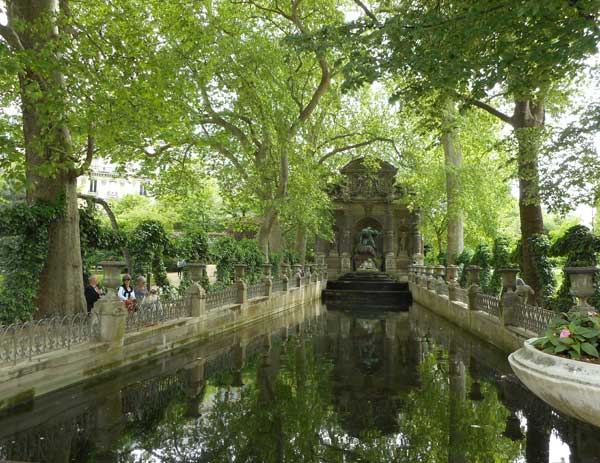 |
| |
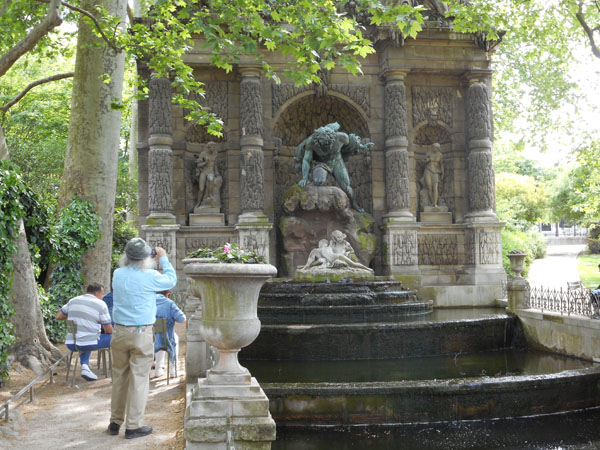 |
| Much of the Jardin du Luxembourg space was paths for strolling under the trees |
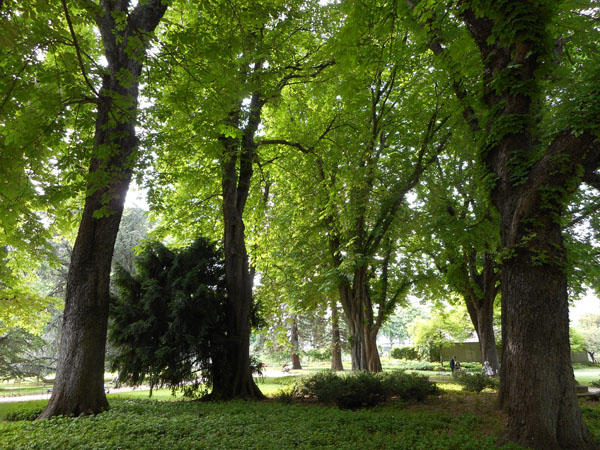 |
| while eating ice cream and other snacks |
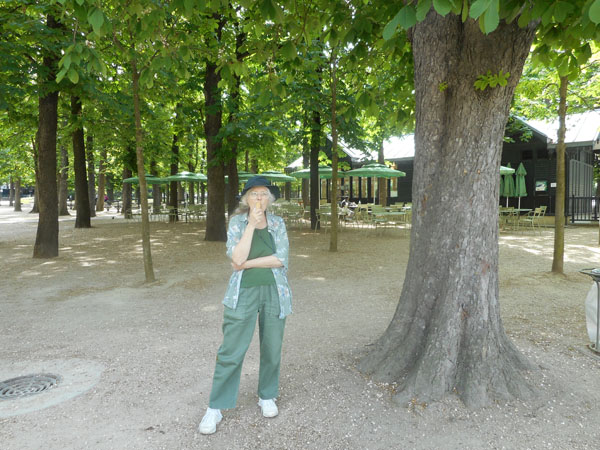 |
| At the north end ot the gardens is the Palais du Luxembourg which now houses the French senate |
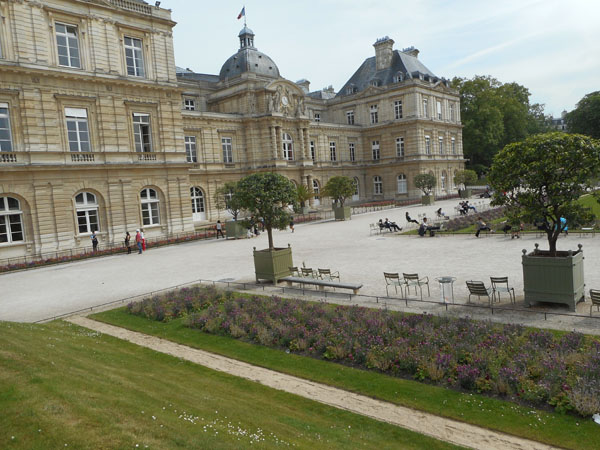 |
| The gardeners were just finishing forklifting the citrus trees into place for the summer. Some of these orange and lemon trees are over 100 years old. |
 |
| Next door is the School of Mines |
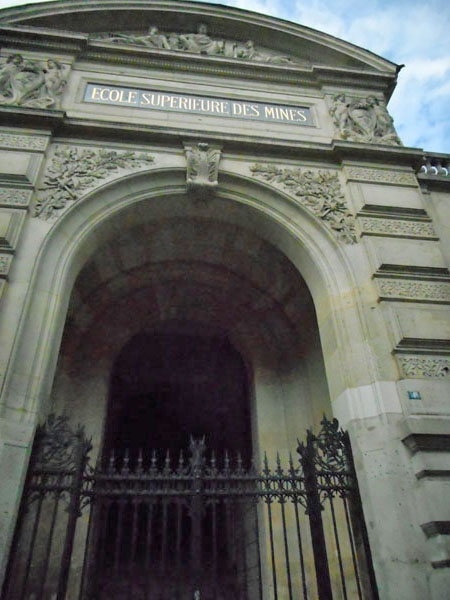 |
| Whose typical school stairway is decorated with paintings of mountains |
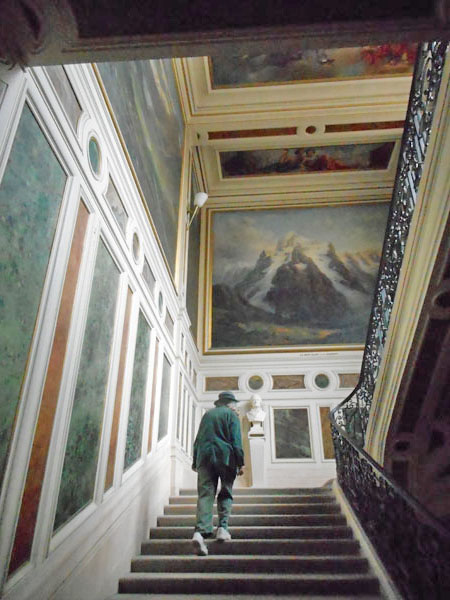 |
| The ceiling has an angel handing laurels. Look closer and you'll see these are men of science, not the usual saints or politicians. |
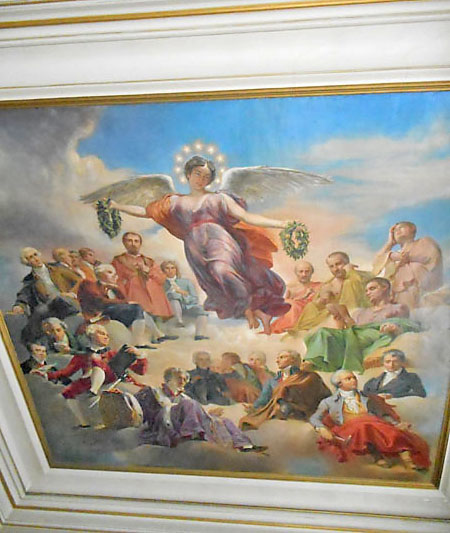 |
| The room at the top of the stairs is the entrance of the National museum of minerology, one of the 10 largest in Europe. |
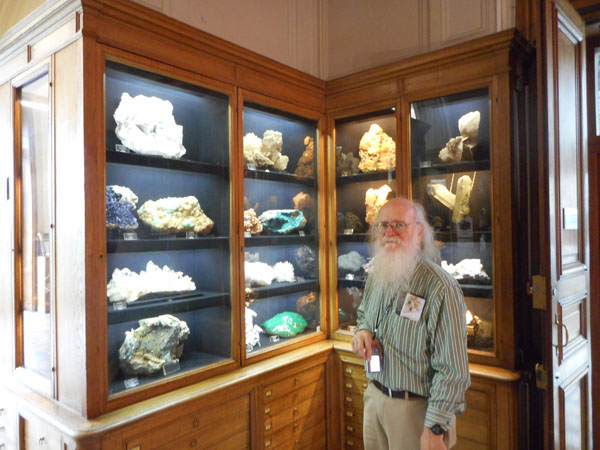 |
| Rooms fading into the distance full of 100,000 rocks in glass cases. We spent the day. (Karen has tried to restrain herself and only show a few examples) |
 |
| In addition to spectacular specimens |
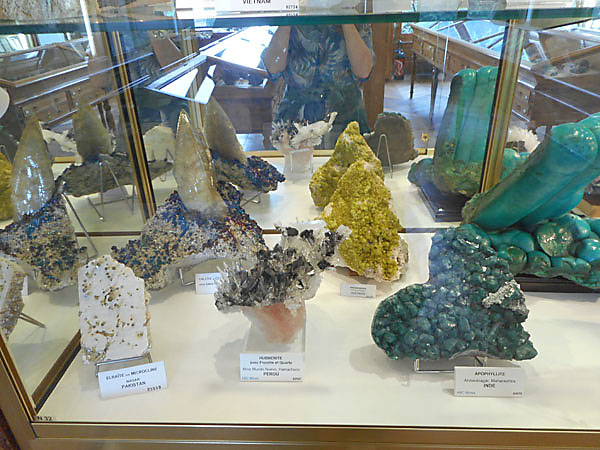 |
They had exhibits of what rocks were found in various areas of France |
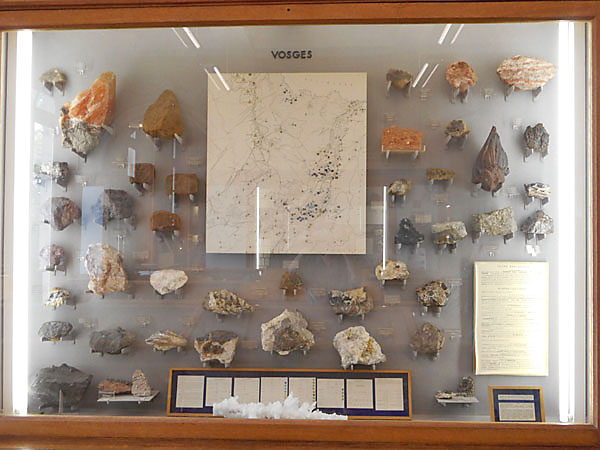 |
| As well as hundreds of cases of rocks laid out by chemical formula with examples of the same type of rock from different places in the the world. |
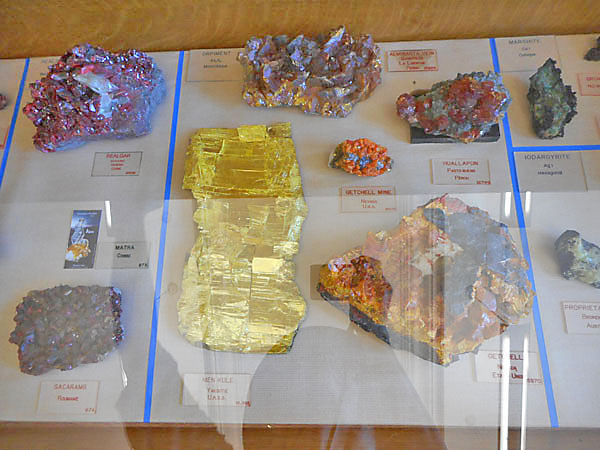 |
| There were displays of minerals used for color in arts and industry and why they were that color. |
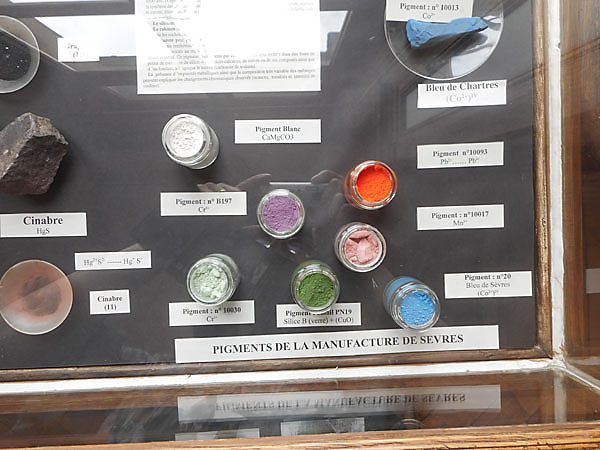 |
| Here's a just part of a display of different colors of quartz and what impurities or electron shell variations give that color. |
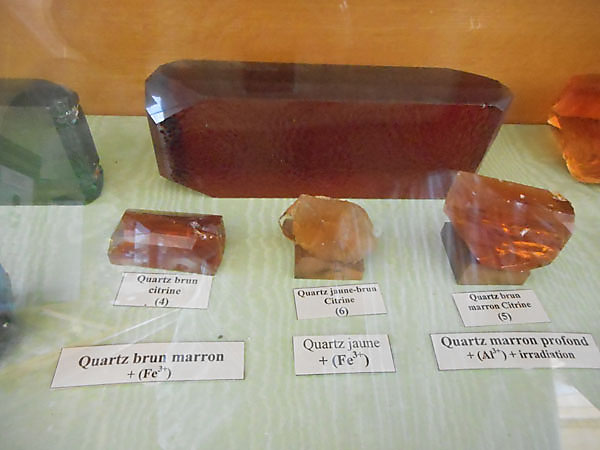 |
| There were several spectacular specimens |
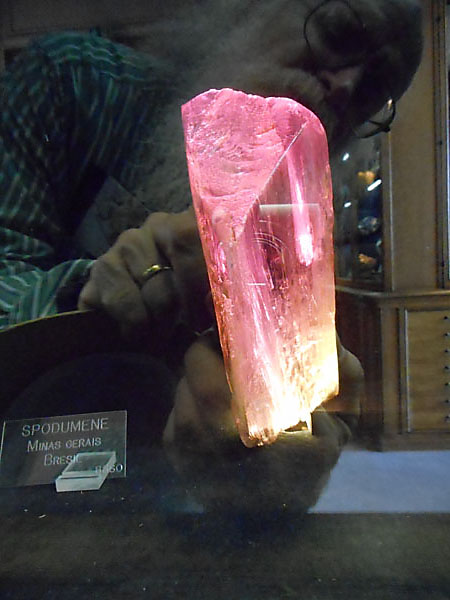 |
| including this meteorite |
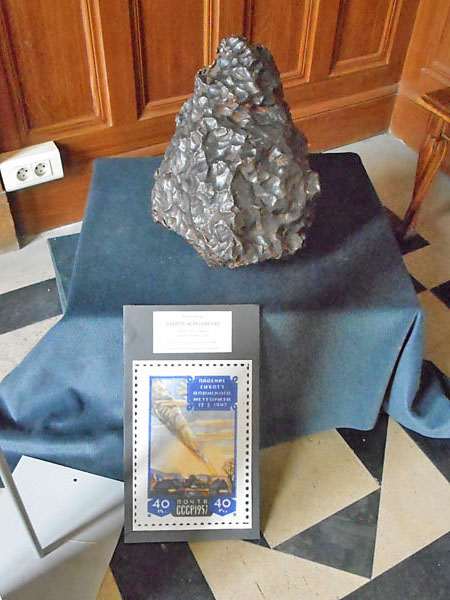 |
| Out in the entry the tiny gift shop would sell you small flakes of gold and a few other common mineral specimens. |
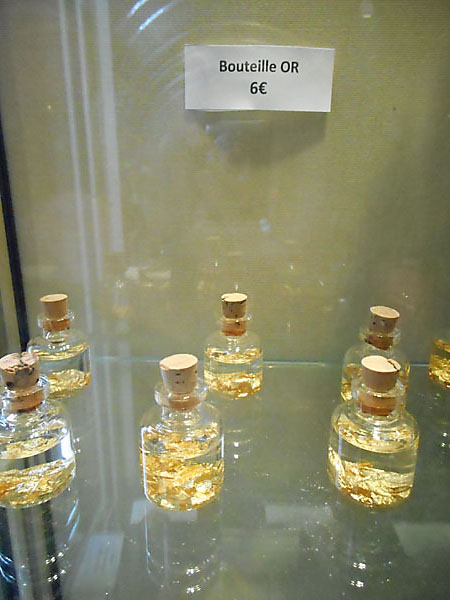 |
| A few blocks away they worked with radium. |
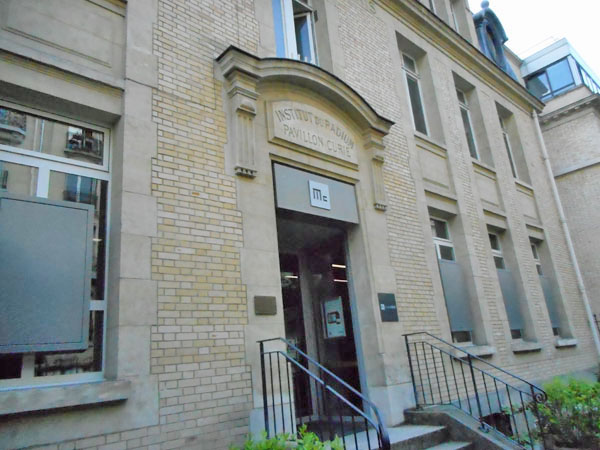 |
| The Curie museum: The original laboratory. Still radioactive (door knobs, chair backs), so we could not enter the room. |
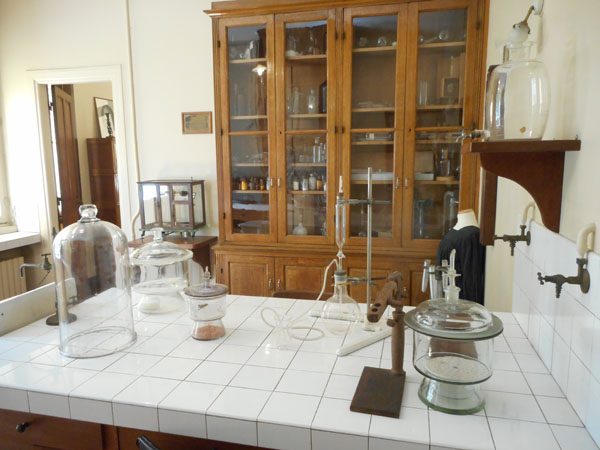 |
| Glass which had turned purple due to radiation (most modern glass won't do this because it is now manufactured differently) |
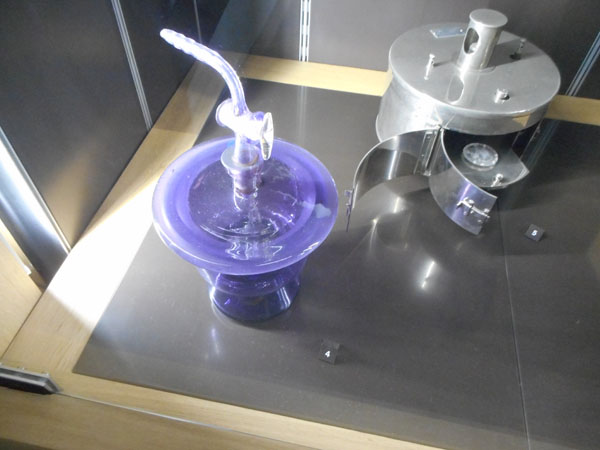 |
| In the more modern (and not radioactive) part of the museum were historical instruments, such as this device for assaying radium |
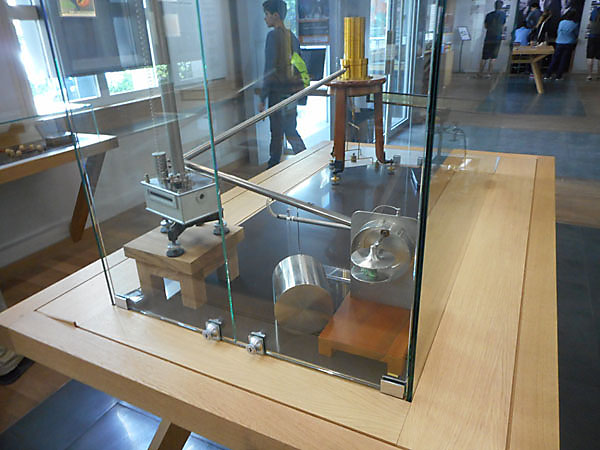 |
| and a "bread-board" Geiger counter |
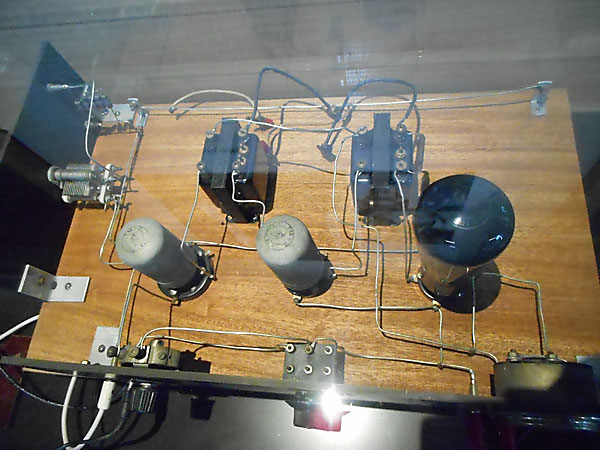 |
| As it turned out, near our apartment on l'Île Saint-Louis is a plaque on an apartment where Marie Curie (two Nobel prizes) and, much later, Rene Cassin (1968 Nobel peace prize) used to live. |
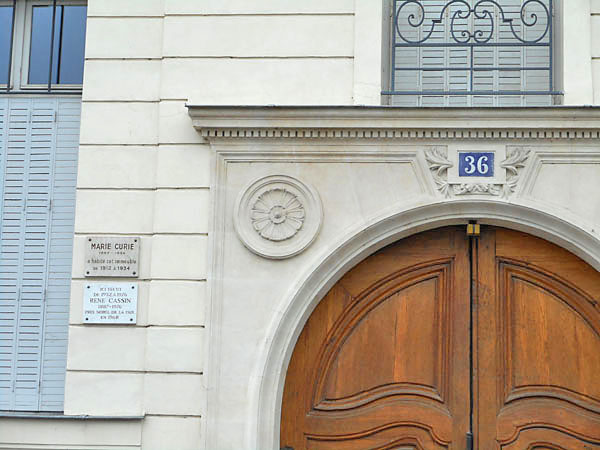 |
| Wandering elsewhere in the neighborhood, Dick noticed familiar-looking labware in a basement window. |
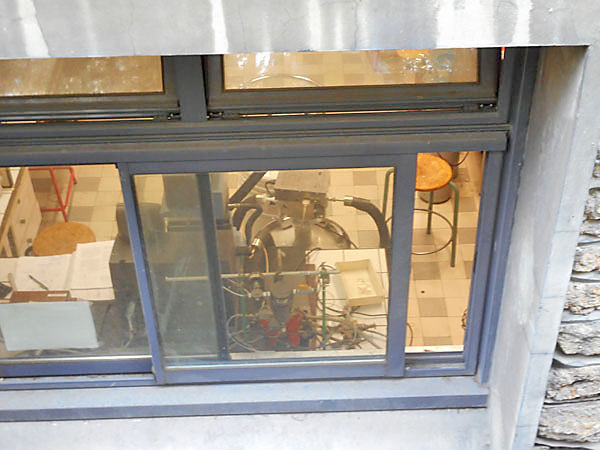 |
| Looking up we saw that it was the public school of industrial physics and chemistry |
 |
| A nearby architect's office has a playful entry. |
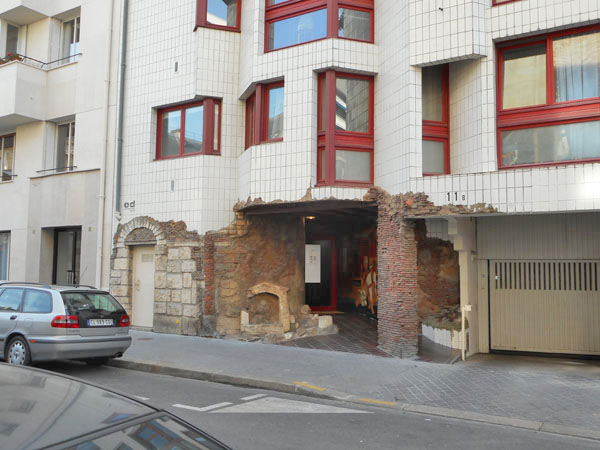 |
| The above wander of streets since Jardin du Luxembourg were all circling the hill crowned by the Panthéon. |
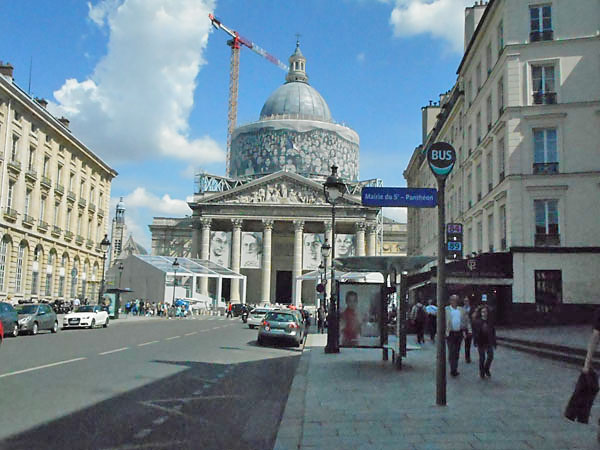 |
| |
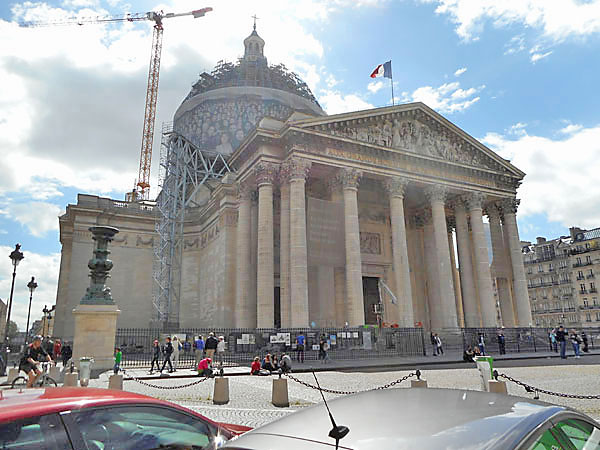 |
It was originally constructed as a church but became a national mausoleum at the time of the first French Revolution. This statue shows France herself standing between the revolutionairies and the members of the Convention National.
The walls have a series of monumental murals depicting the History of Paris as mediated by various historical religious and revolutionary figures |
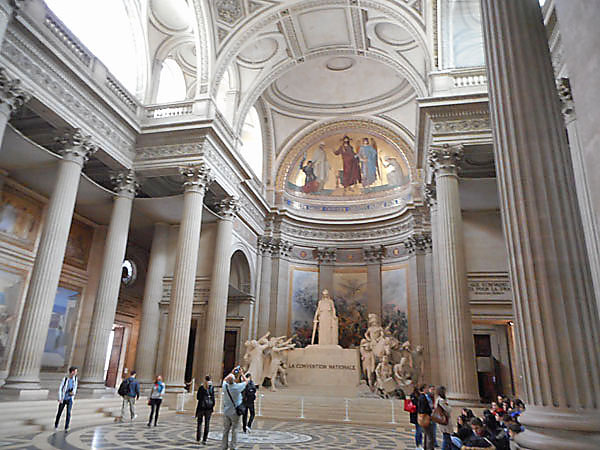 |
| Here is where Foucault set up his original pendulum to prove that the earth rotates.. Because of the ongoing dome restoration, it was moved from here to the Museum Arts et Mietiers (which you saw in our North Loop) |
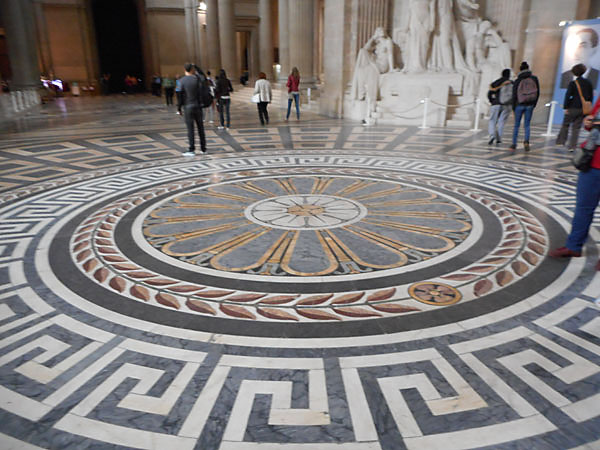 |
| The original model of the building is also on display |
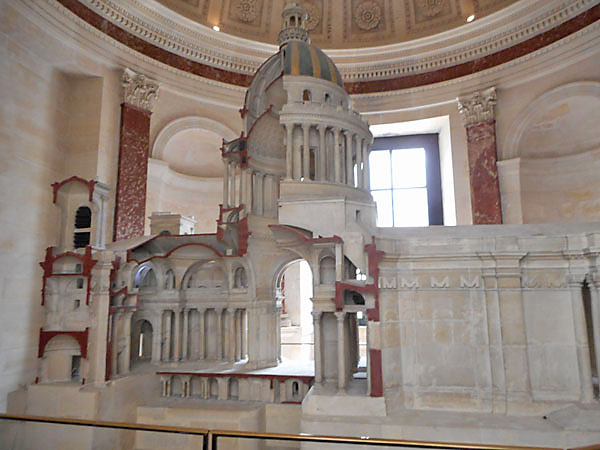 |
Down in the basement is the crypt: doors leading to rooms with famous people interred within, including Pierre and Marie Curie.
("interred" is a slight mis-statement. Some honorees are represented by only their hearts (in urns), or their bodies without their hearts, or merely soil from their actual graves when the families requested that their remains remained undisturbed) |
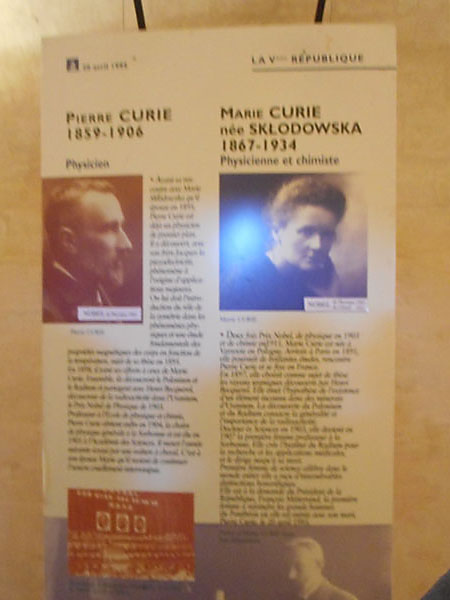 |
| Back outside, we descended the hill's east side to reach the Jardin des Plantes. Outside is a mix of the usual French plant sculpting and more natural plant forms... |
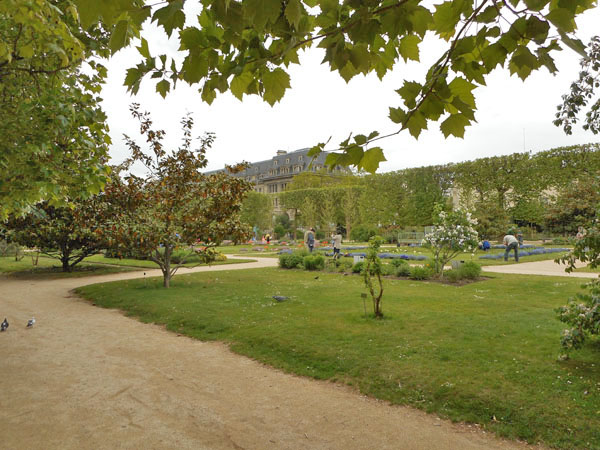 |
... in some areas predominently the "sculpted".
The monumental buildings contained museums of zoology (shown), minerology (columned entrance in distance), paleontology and comparative anatomy. |
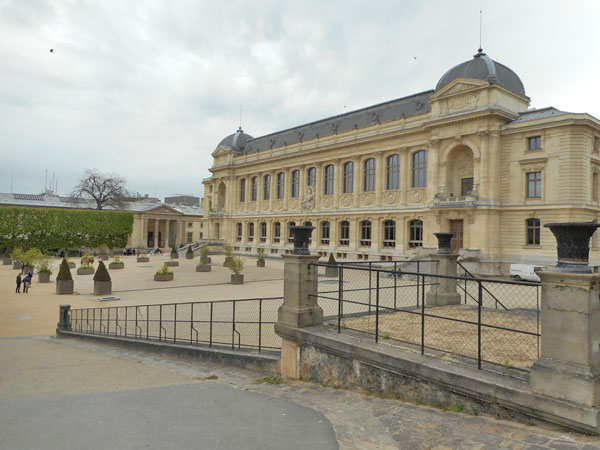 |
| There are a series of greenhouses (with entry fee, hence guard) |
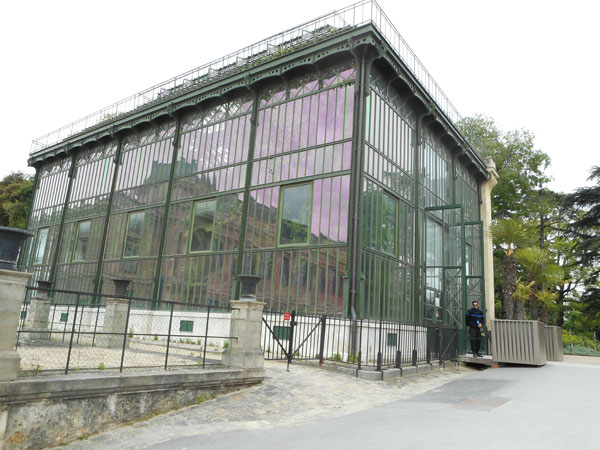 |
| Karen's obligatory tree fern photo (see our other travels... tree ferns will appear) |
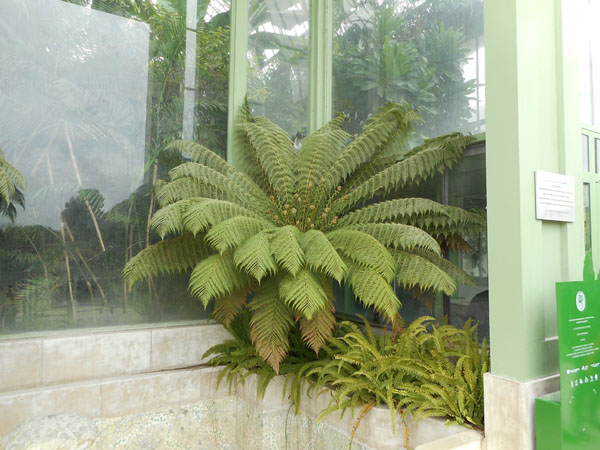 |
| The desert house |
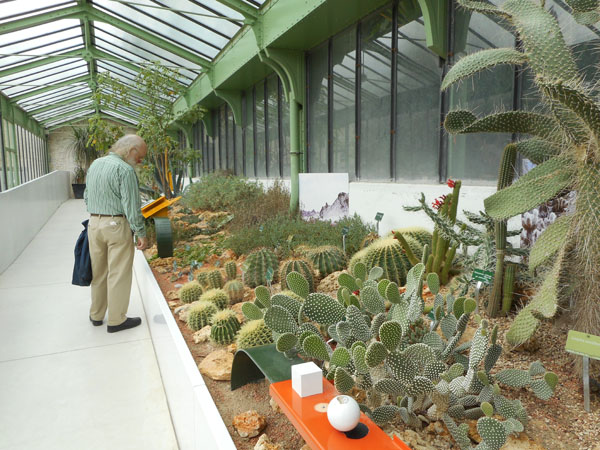 |
| They have an interesting trellis for their vines in their tropical house |
 |
| At the end of which is a tower to allow you to climb to the building on the next level |
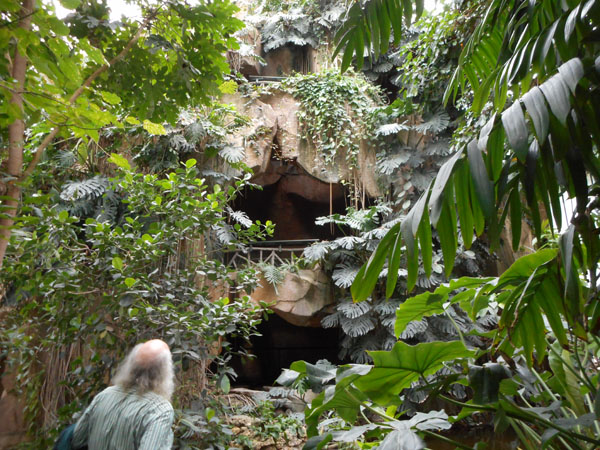 |
| Nice view down |
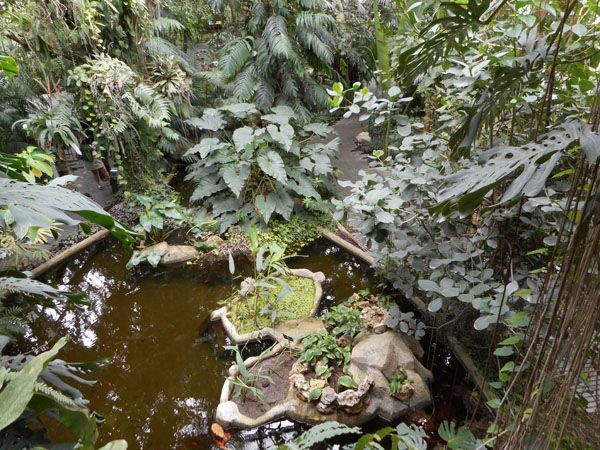 |
| The glass cube seen at the beginning of this sequence houses an essay on plant evolution |
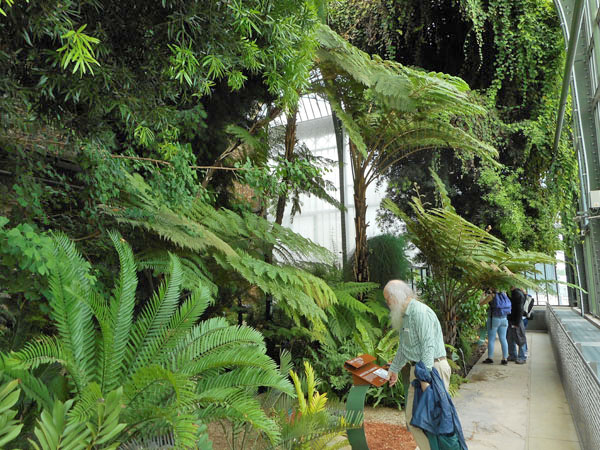 |
| Outside again we decide not to go to the small petting zoo, but head into the next building |
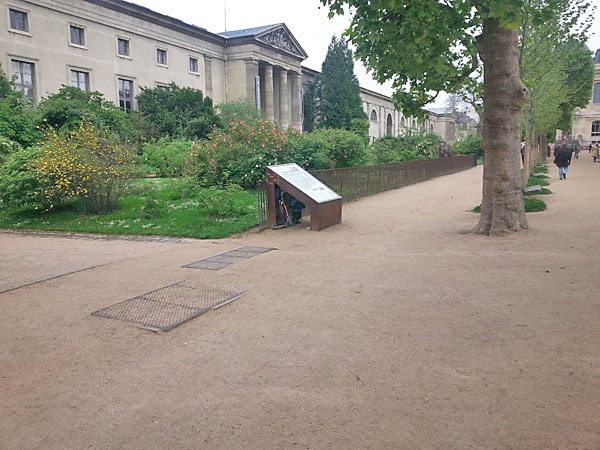 |
| For the small but amazing minerology display. Well worth the fee to see well-lit crystals the size of people. |
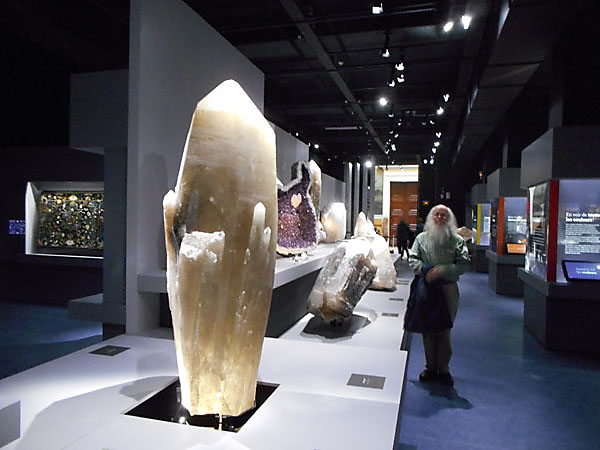 |
| The smaller samples were also exquisite |
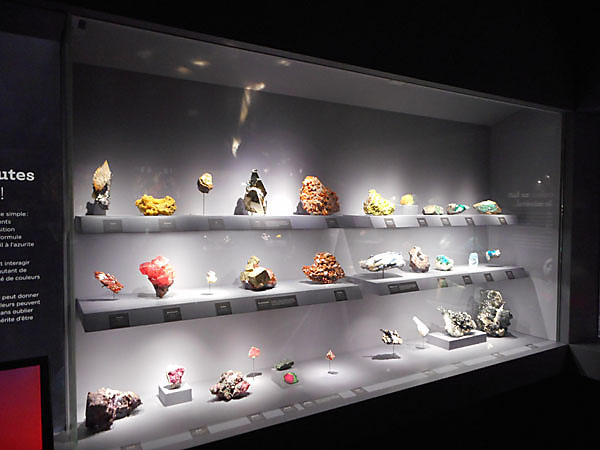 |
| |
 |
| Compare these to the less theatrical (but accessible-for-research) cases and drawers of the School of Mining. |
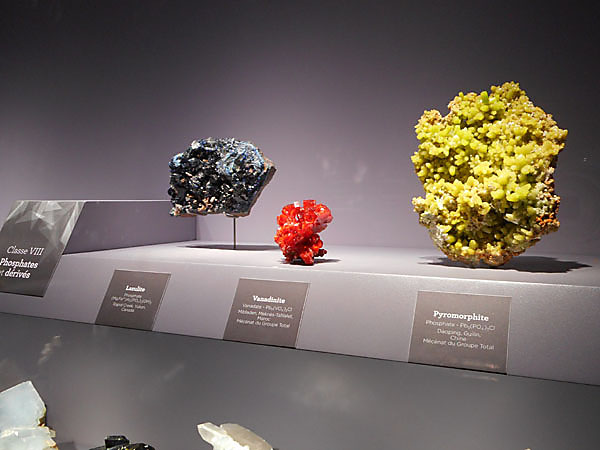 |
| |
 |
| Karen is trying to restrain herself (again) and show only one of the examples of worked stone: this gorgeous inlay. |
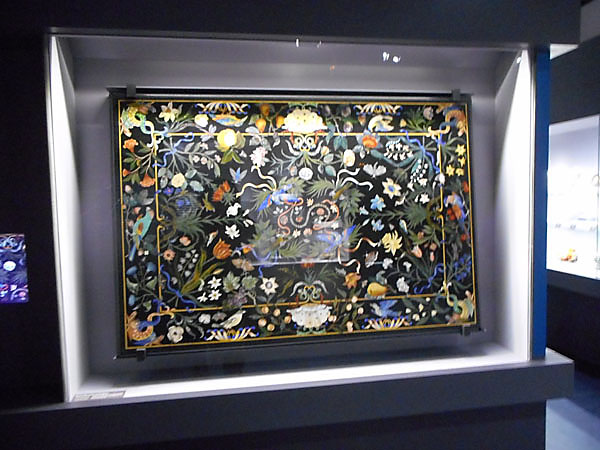 |
| Chased out by "closing time", we strolled the remainder of the gardens |
 |
and crossed the street to the Seine. This is the Musee de La Sculpture en Plein Air (we'd say sculpture garden)
This day it was also a display of Tango. |
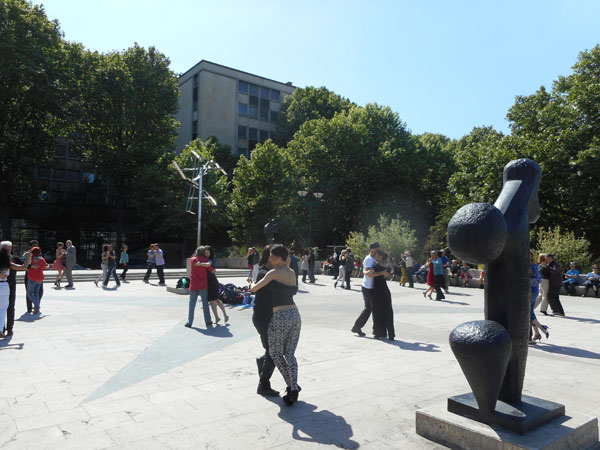 |
| Relatively durable public art. |
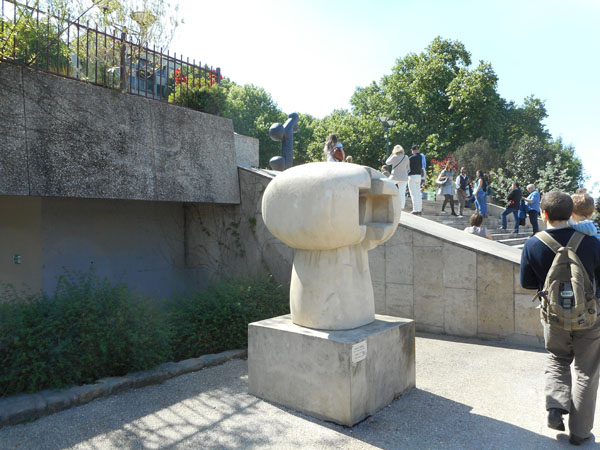 |
| |
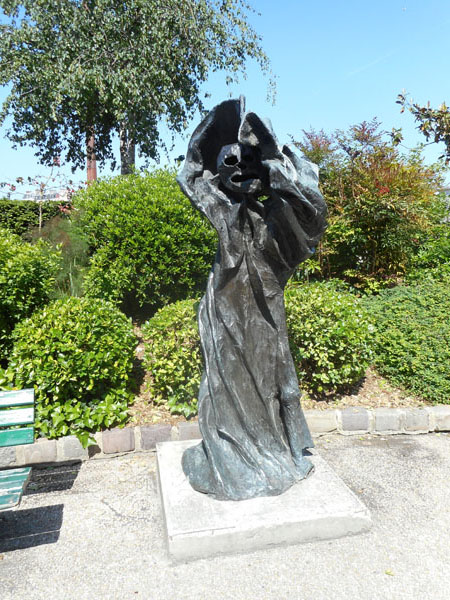 |
| |
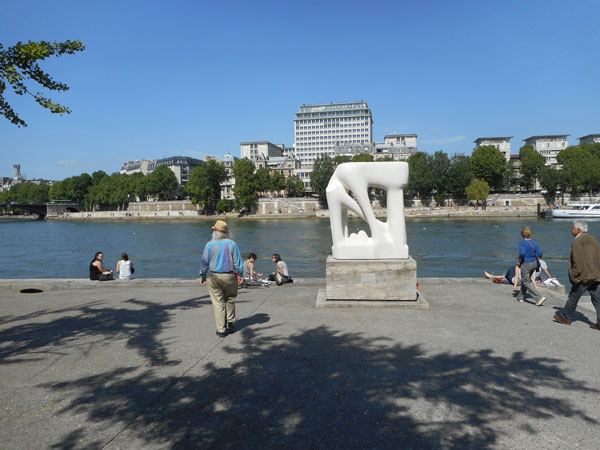 |
| Some puzzling but playful... |
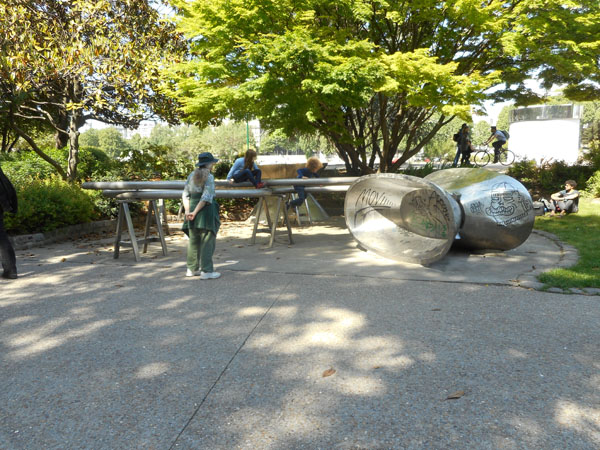 |
| |
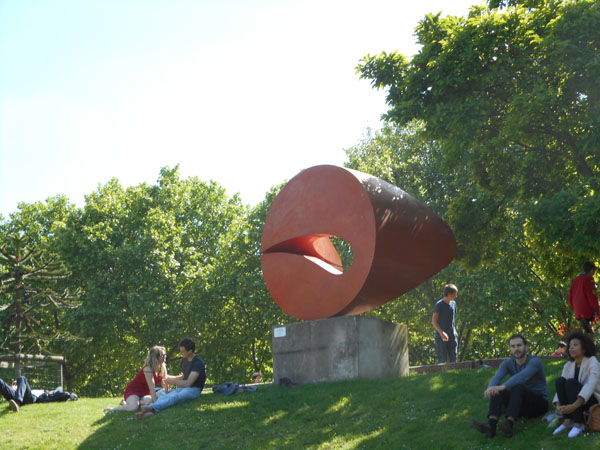 |
Dick couldn't at first figure out if this was a sculpture or a piece of infrastructure
(it was art, and performed magic with the round mirrors) |
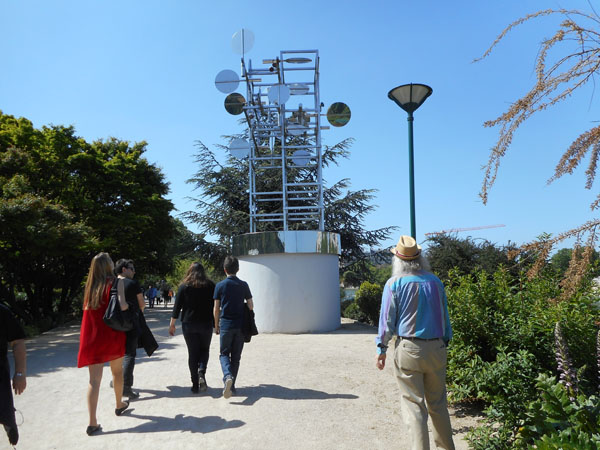 |
| |
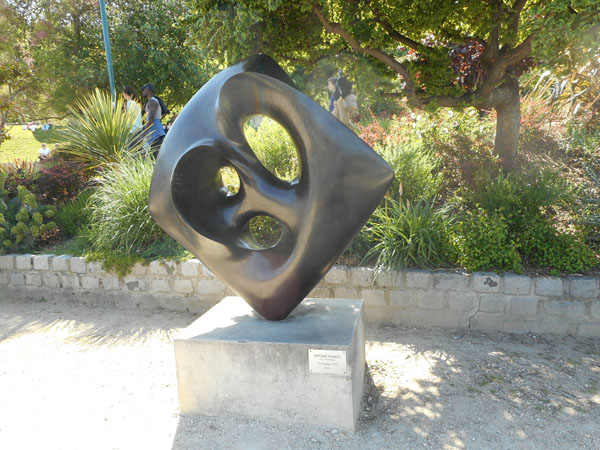 |
| The park also includes workout devices |
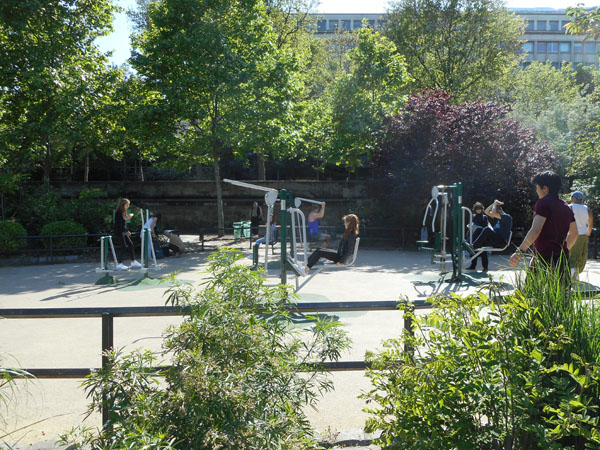 |
| Across the river is the final lock of the Canal St Martin, where it empties into the Seine. |
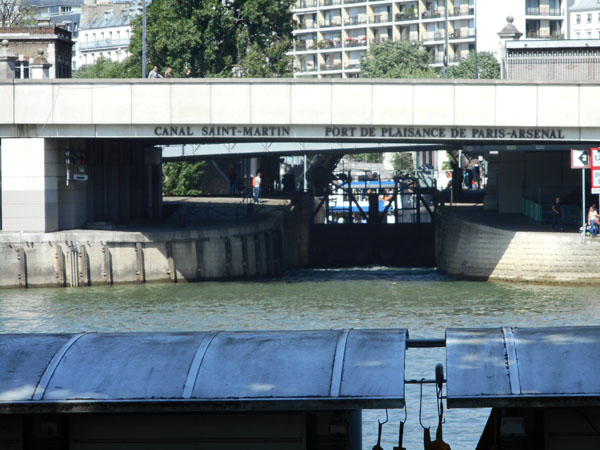 |
Lower the water.
boats come out
(from the "Port of Pleasure") |
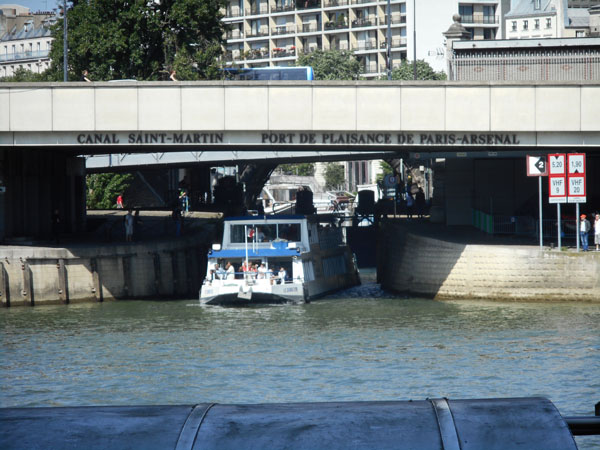 |
boats go in
raise the water
all day long |
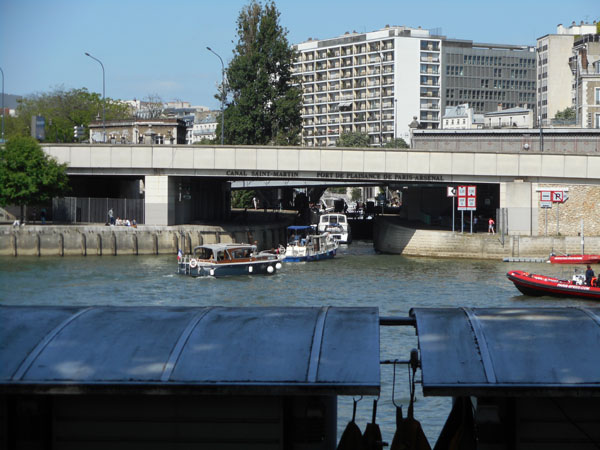 |
| Here's the small mooring area and barge passage at the top of the lock. Note the tower of the Place de la Bastille at the far end. |
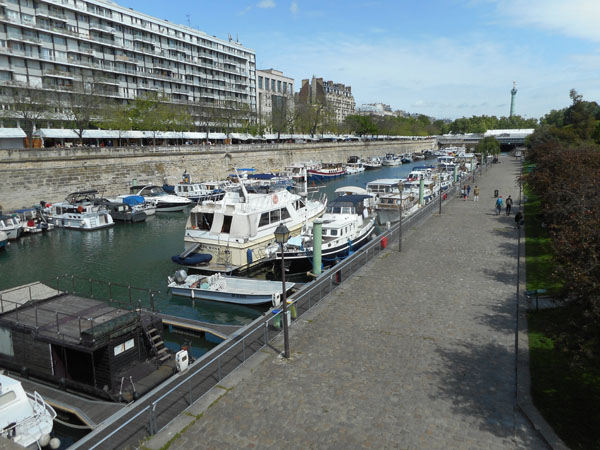 |
| Place de la Bastille (remember the Bastille itself was torn down by angry crowds at the beginning of the French revolution) is also the location of the current opera house, Opera Bastille (you saw the old one, Opera Garnier, in our North Loop). |
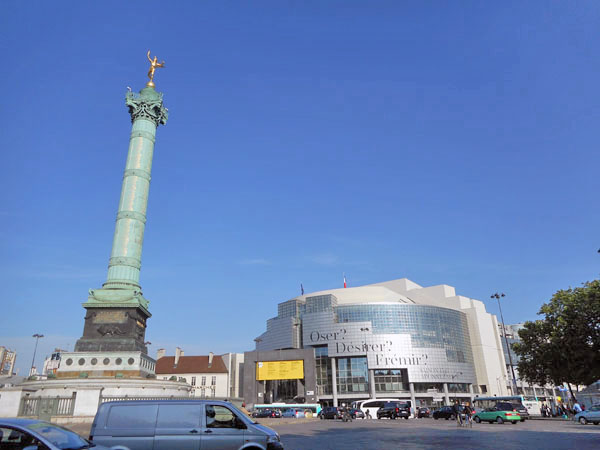 |
| There was also an antique fair going on |
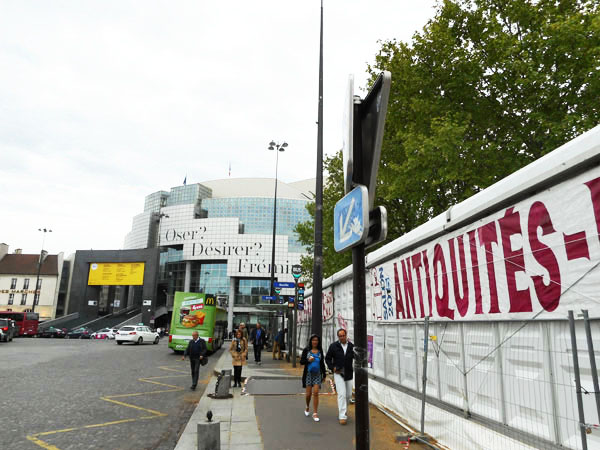 |
| With an imposing samovar. |
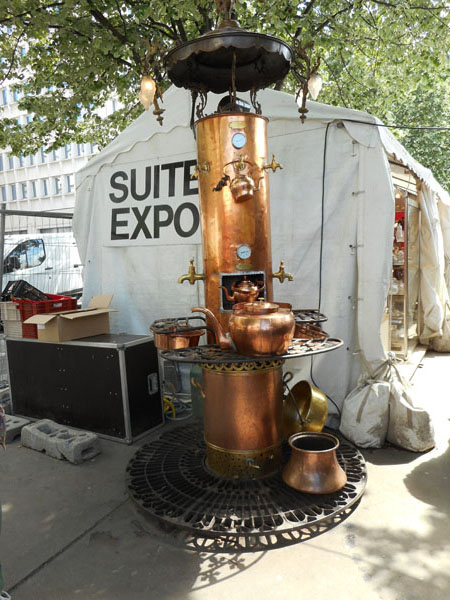 |
| There were also several antique stores in the area |
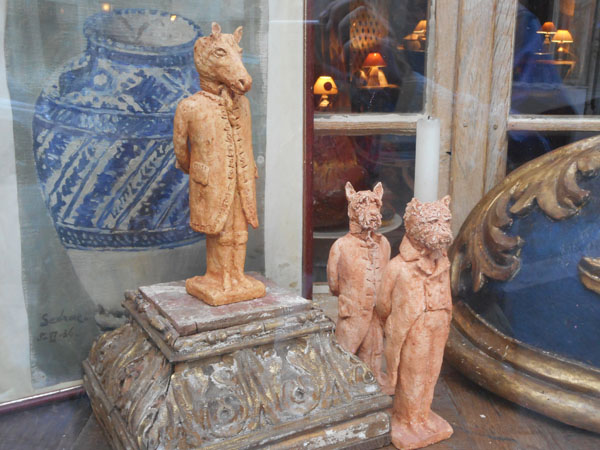 |
| and a restaurant with very French seating... |
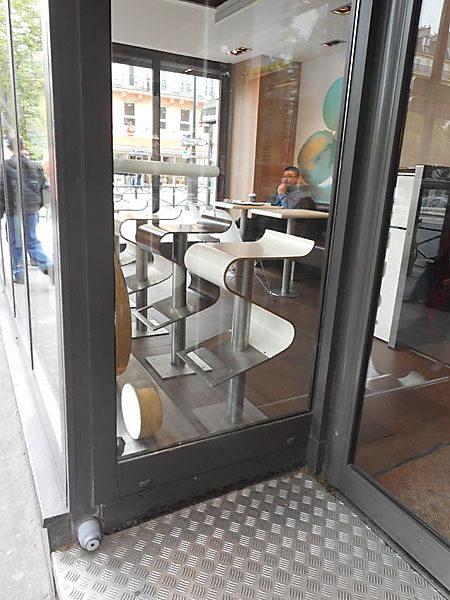 |
| ... under a familiar logo. |
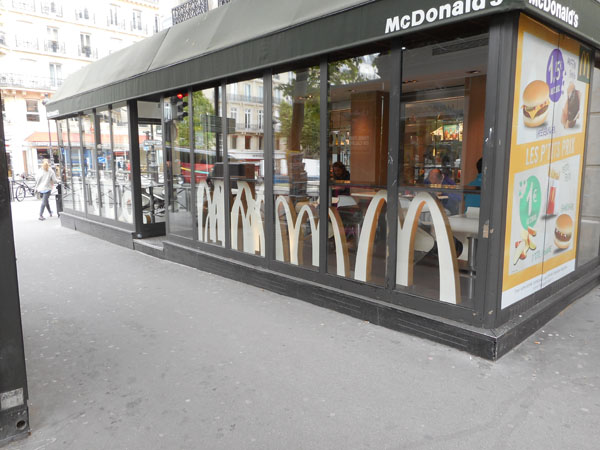 |
| Back to the Canal St Martin... it goes underground at Place de la Bastille. Above it is Boulevard Richard Lenoir, a paired street (dual carriageway). A linear park is laid out over the canal and between the boulevard's two opposing one-way streets. The park is mostly tree-lined and walled with occasional bridges like this one crossing it |
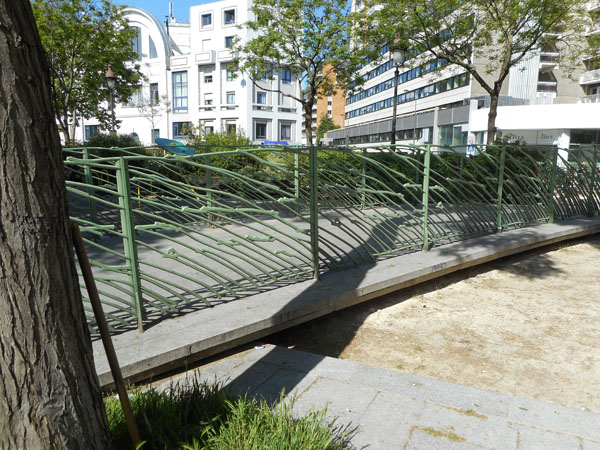 |
| The walled areas are full of various things like children's play equipment or more adult play equipment like this cement ping pong table. |
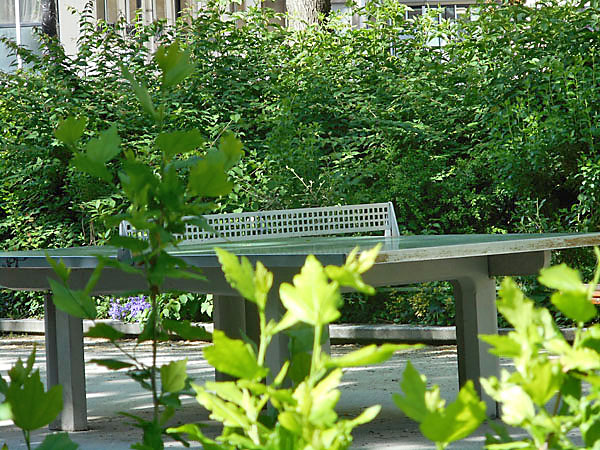 |
| There were occasional light and air wells for the canal passing underneath. |
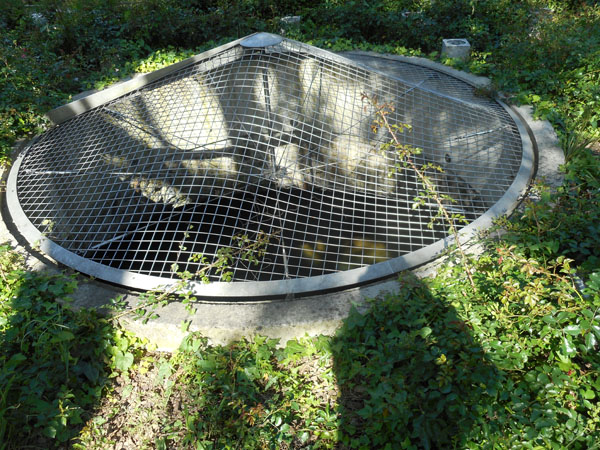 |
| After over a mile underground (and a corner), the canal comes to light again northeast of the Place de la Republique |
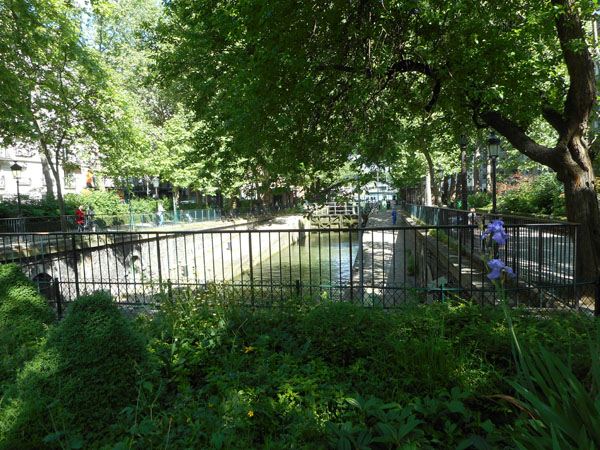 |
| with another lock |
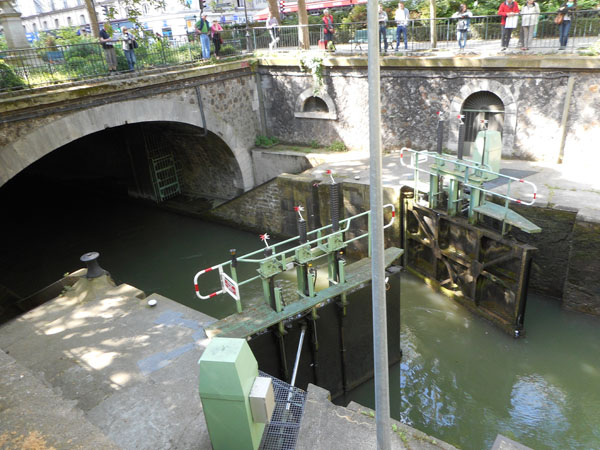 |
| and boat traffic |
 |
| It's a three-gate lock, to give shorter boats (or light traffic) faster fill/empty cycles. |
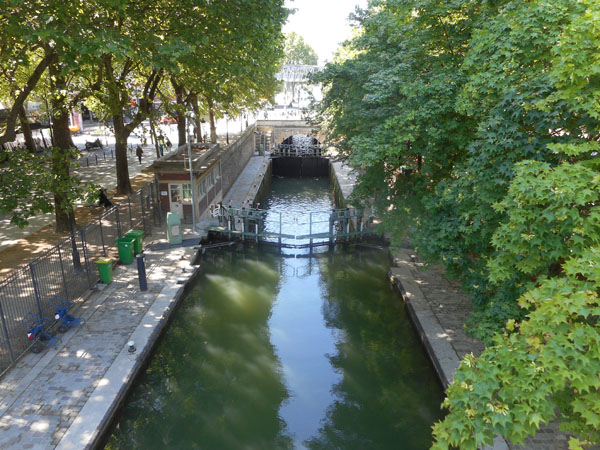 |
| There are tour boats which ply the canal and locks. |
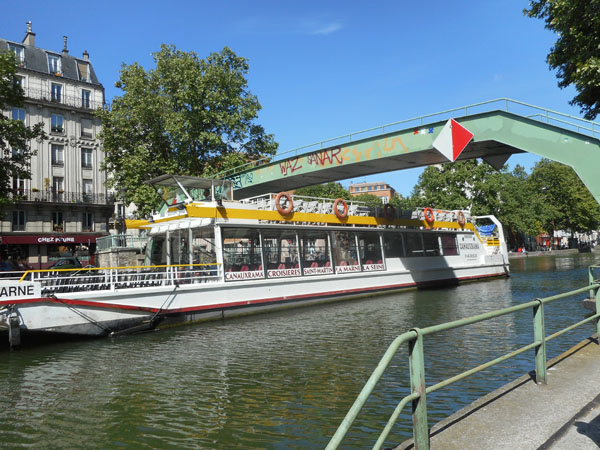 |
| We don't know if he's going to risk eating what he catches or if it is just catch and release. |
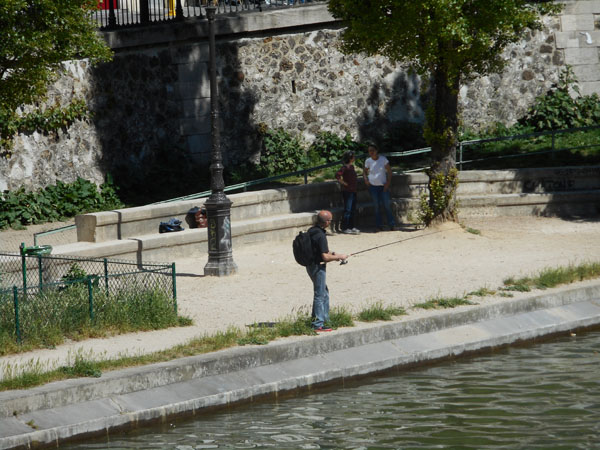 |
| After a few more wider (and narrower) stretches... |
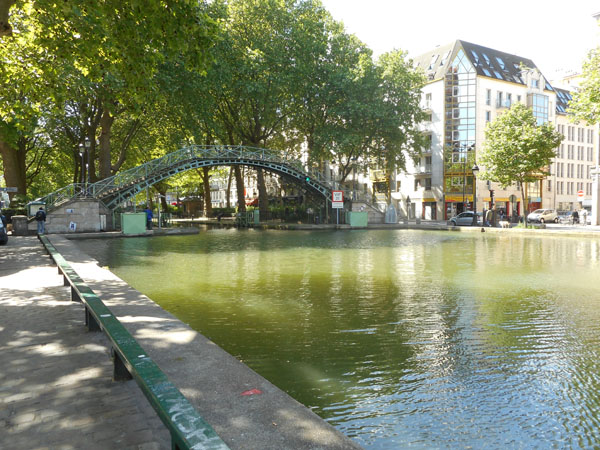 |
| ...the canal broadens out into the Basin de la Villette, almost 4 miles from the Seine. |
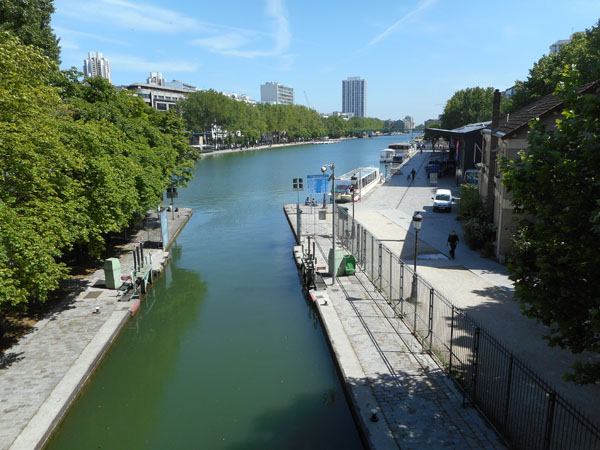 |
The park at this point has a nice fountain.
If we had continued along the Bassin and the subsequent canal, in less than a mile we would have reached a junction of two other canals (and the Cite des Sciences et de l'Industrie), and soon after that, Paris' Boulevard Peripherique. |
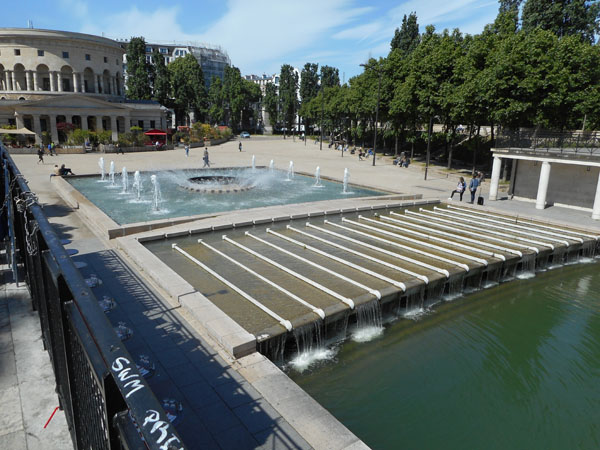 |
| Instead, we turned right (east) and left the water. Six blocks along is the sub-city hall for that (19th) arrondissement |
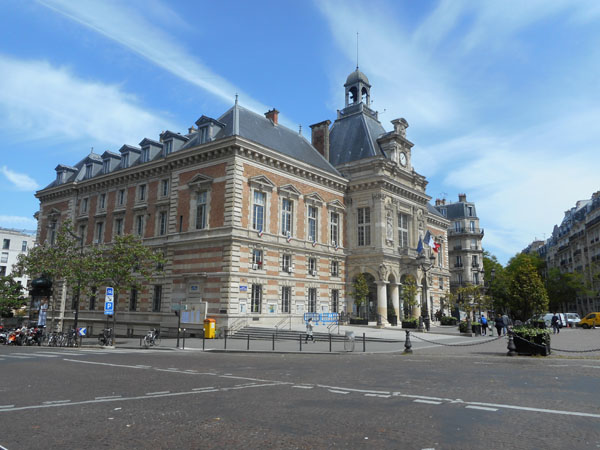 |
| ...Which faces on to the Parc des Buttes Chaumont. Yes, that's "hills of Chaumont". |
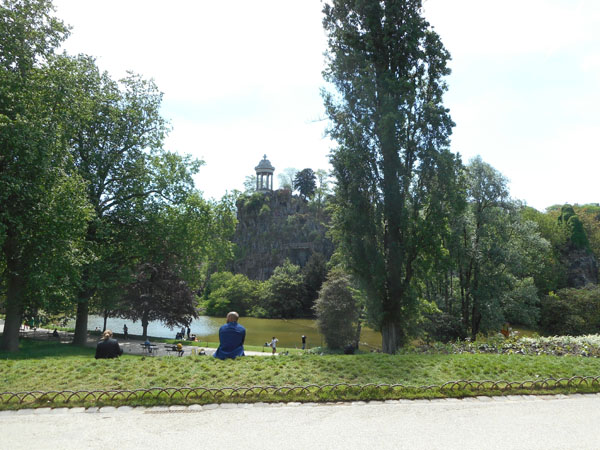 |
| Parts of it were under renovation but it is still worth the trip |
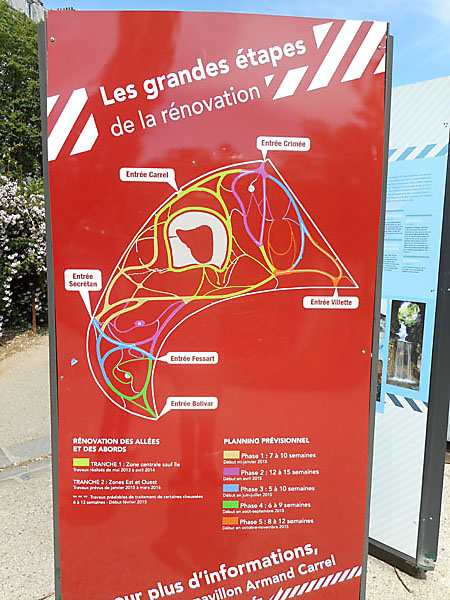 |
| An idyllic textured landscape.. |
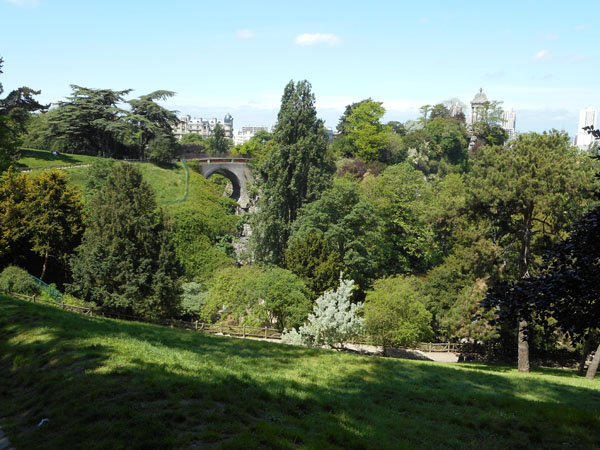 |
| |
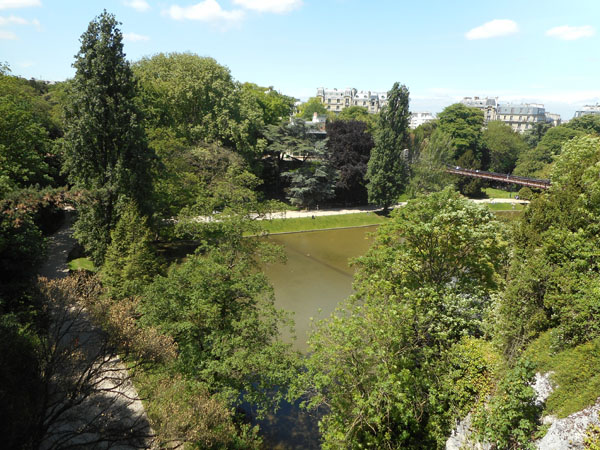 |
| |
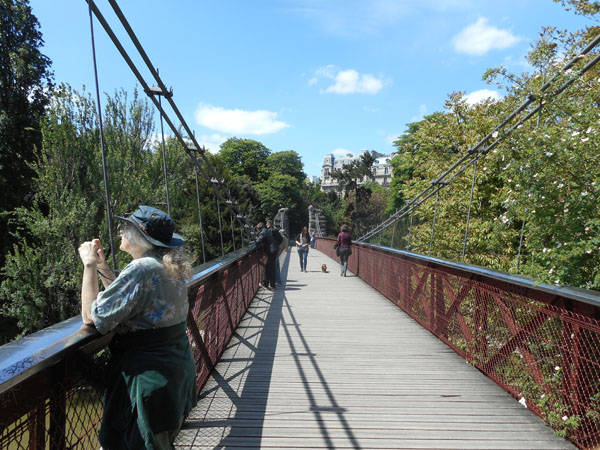 |
| We decend into an area which seem more ordinary (less wealthy) |
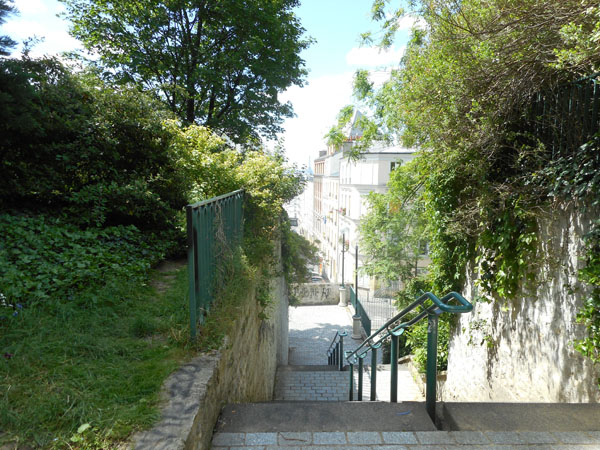 |
| The graffiti is high class though |
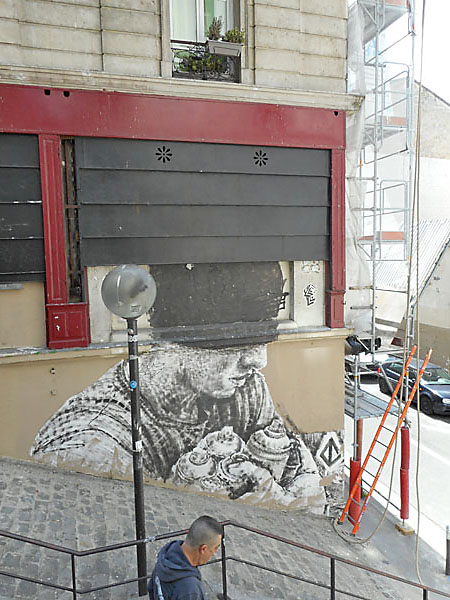 |
| next is Parc de Belleville |
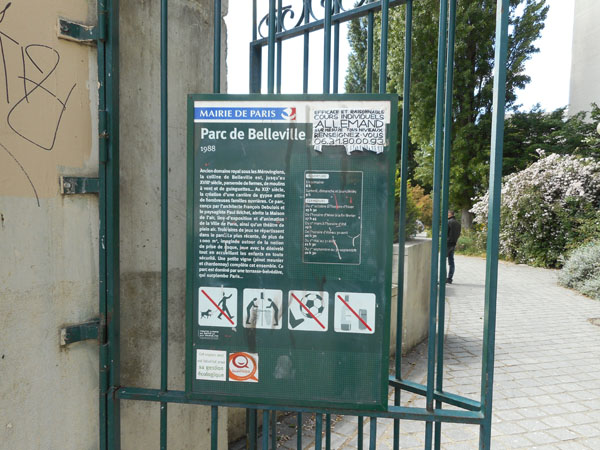 |
| it too has great views |
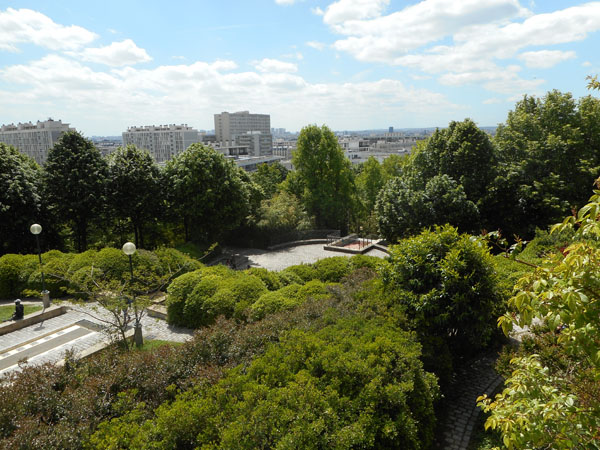 |
| The pavillon at the top |
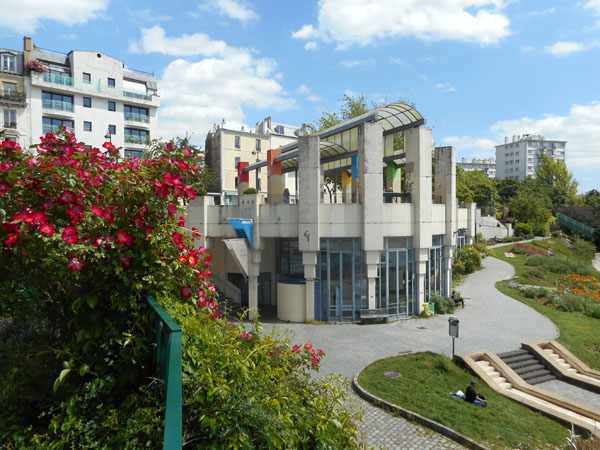 |
| Has an interesting mosaic |
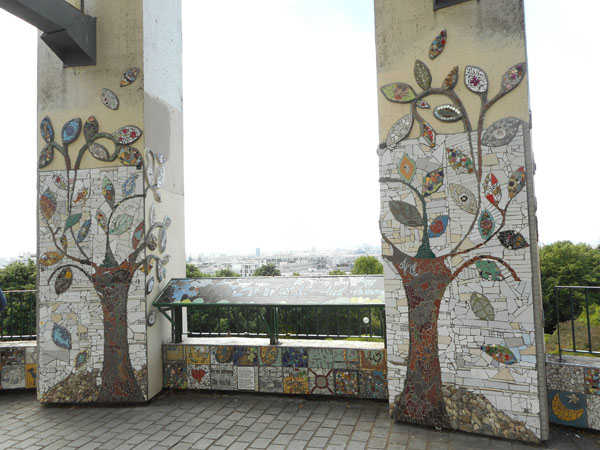 |
| Including the usual here-are-the-names-of-what-you-are-seeing display with a twist. The kids added future items like a spaceport so it won't become obsolete. This was one of Karen's favorite art installations of the entire trip. |
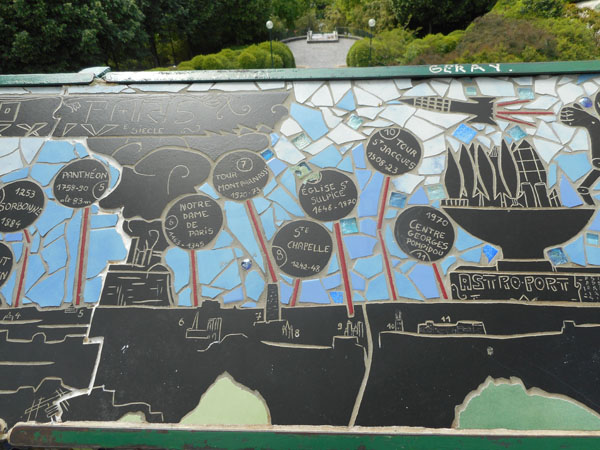 |
| Climbing down Belleville's hill |
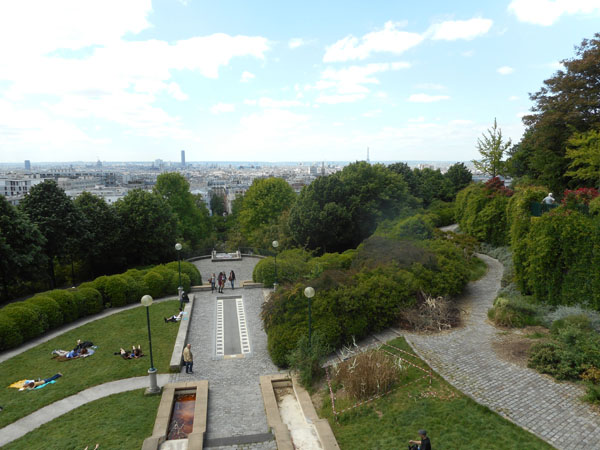 |
| We run into wall art featuring the French revolution's rights of man declaration. |
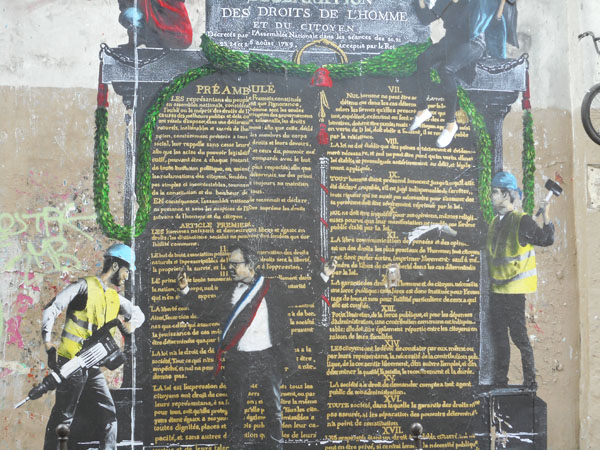 |
| Somewhere along the lower streets, we came across an ancient city well still flowing |
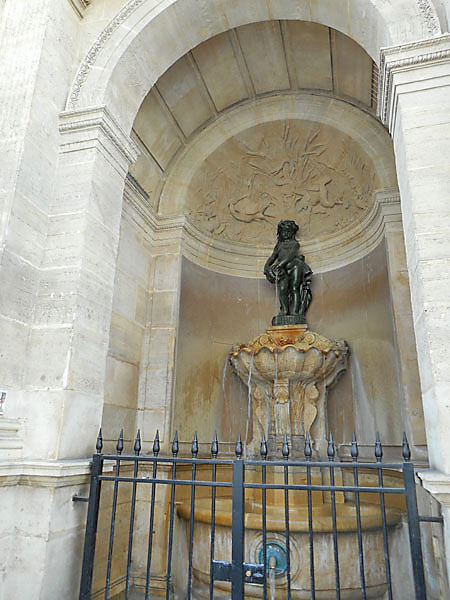 |
And a more modern curb-side gas station - Dick was wondering what the price of gas was and where Parisians bought it. (remember that the prices you are seeing are for a litre (about a quart))
Now travel with us to two "forests" (Boise) on the east and west edges of the city. |
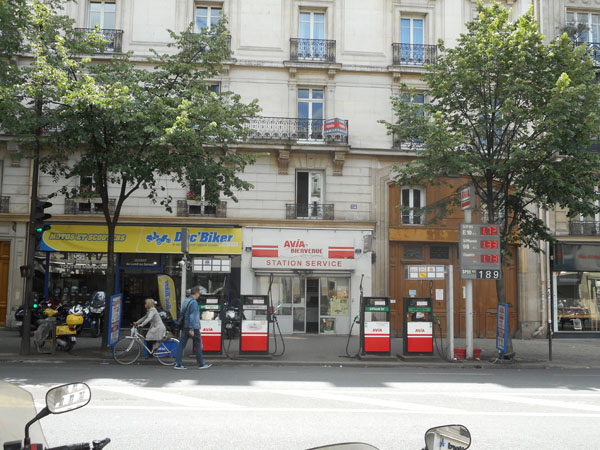 |
























































































































